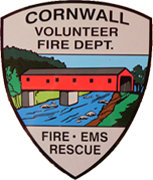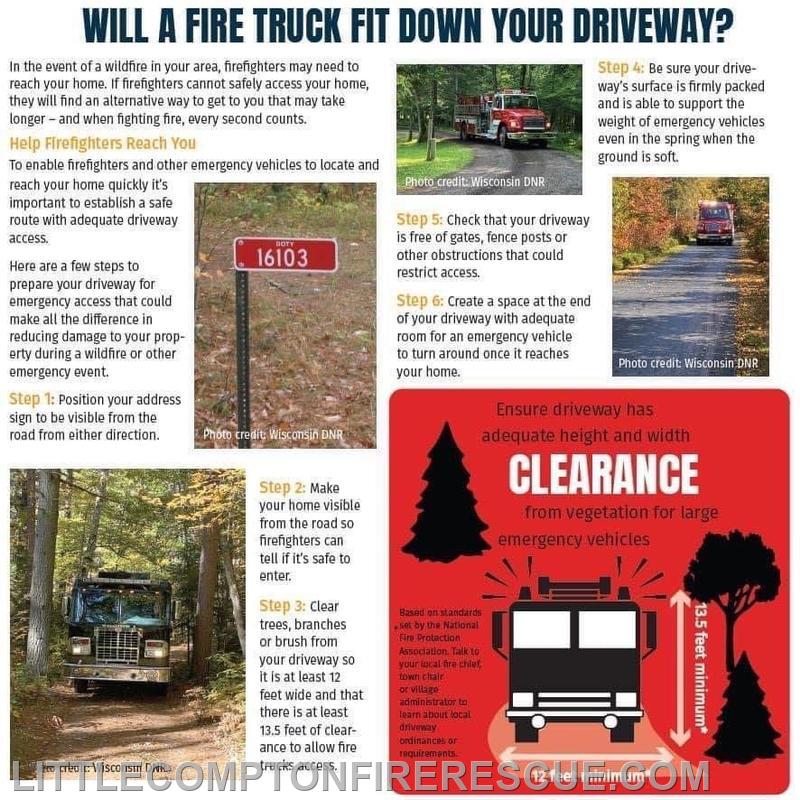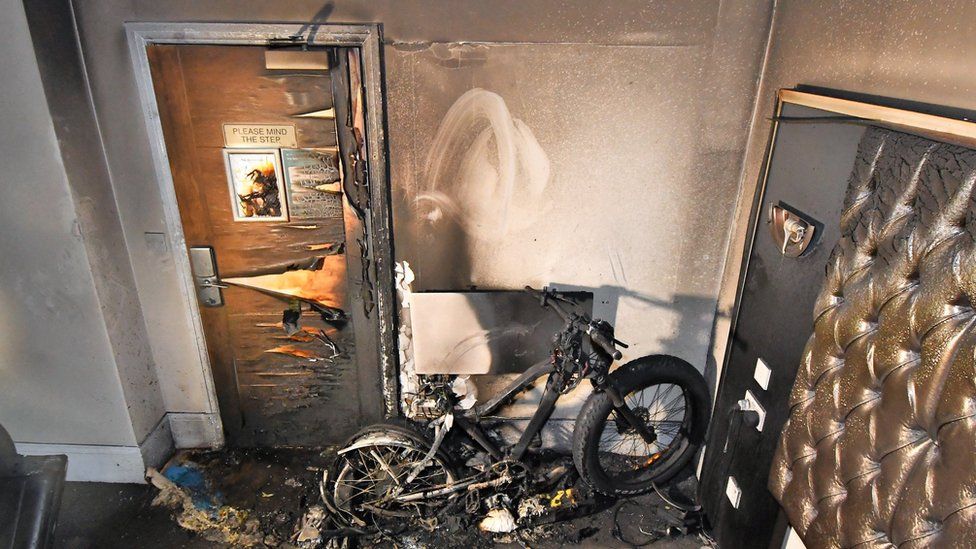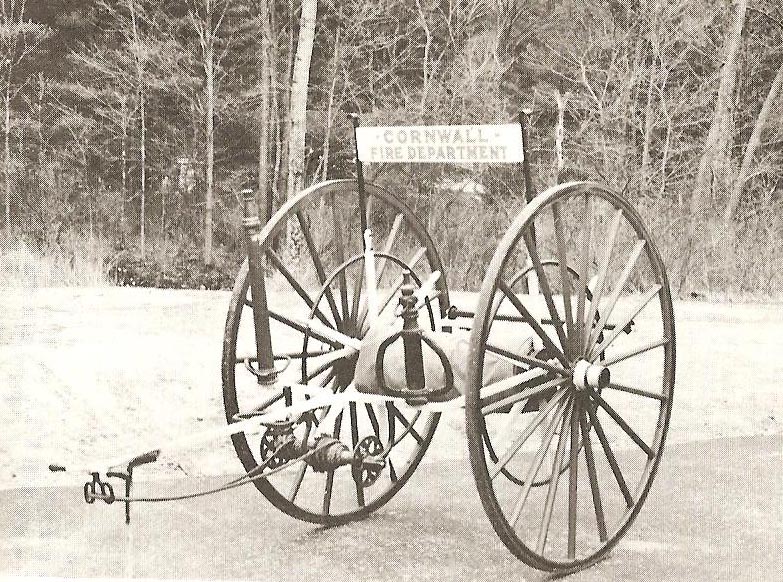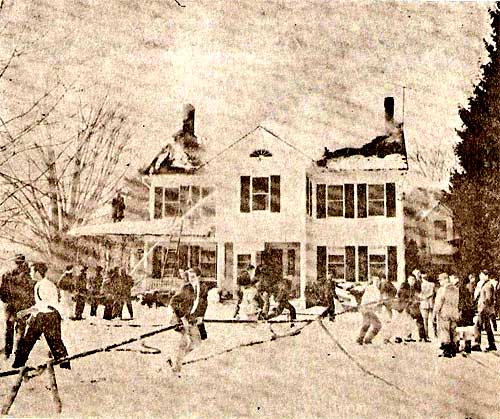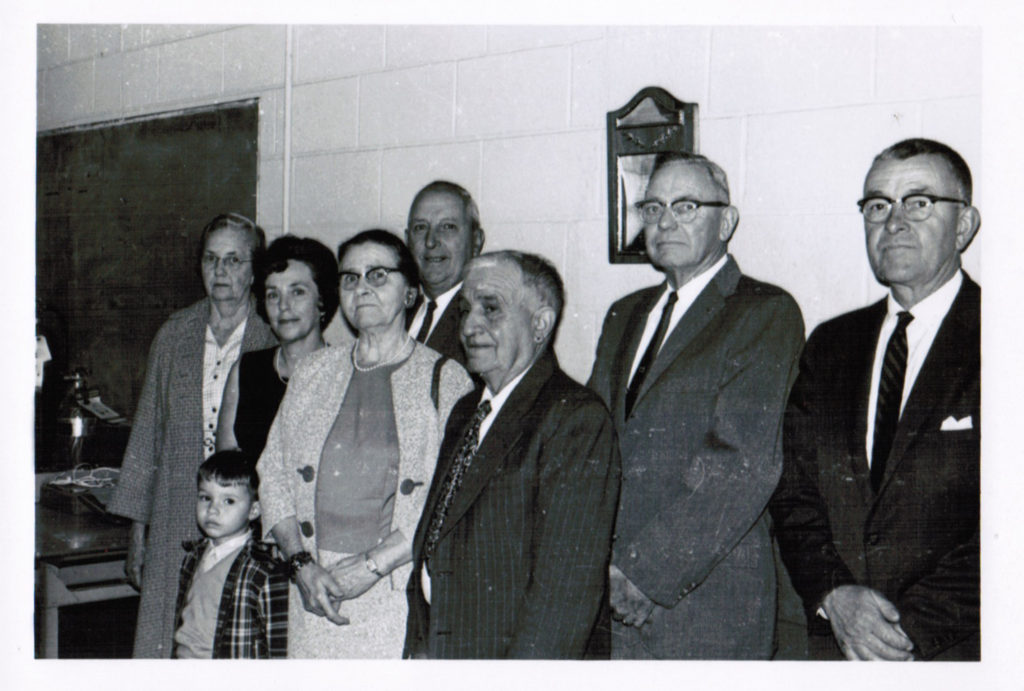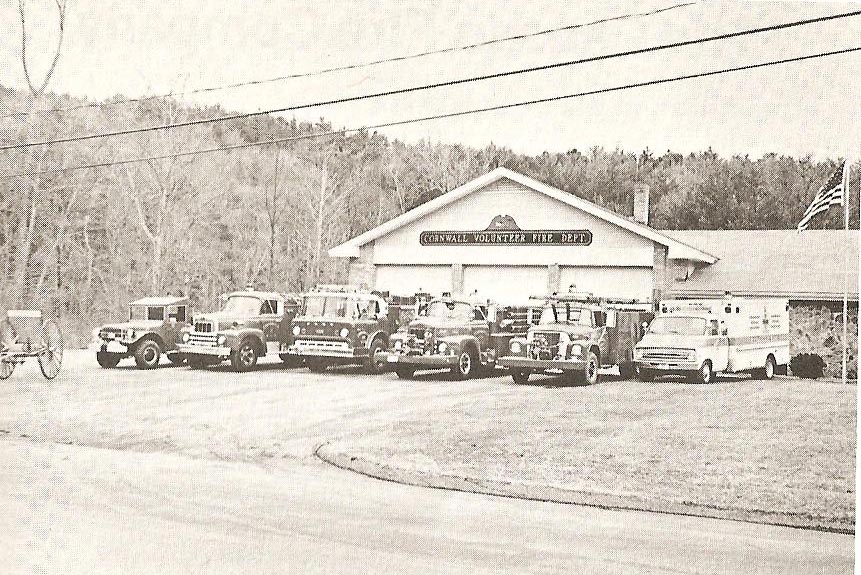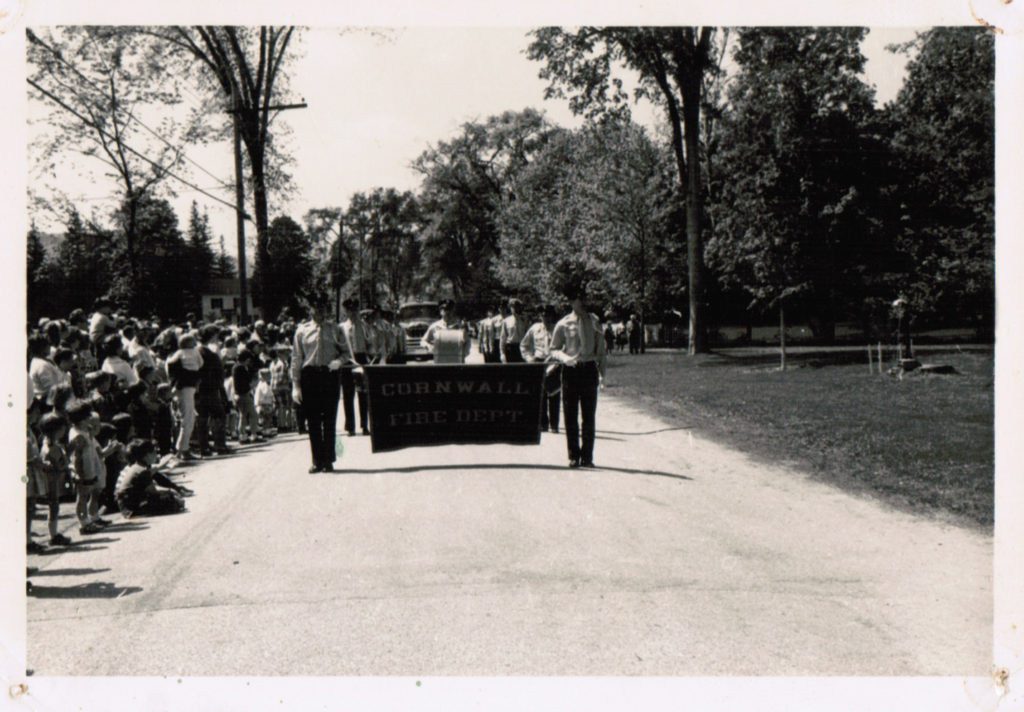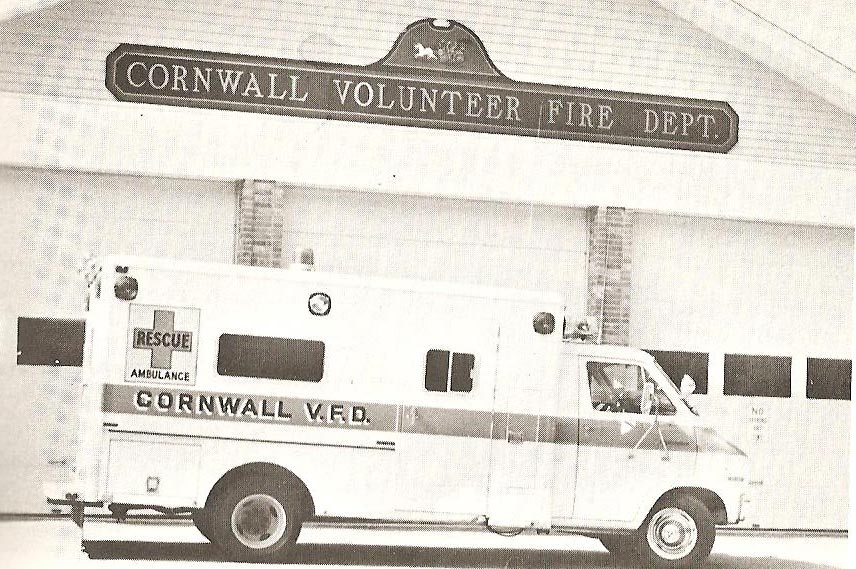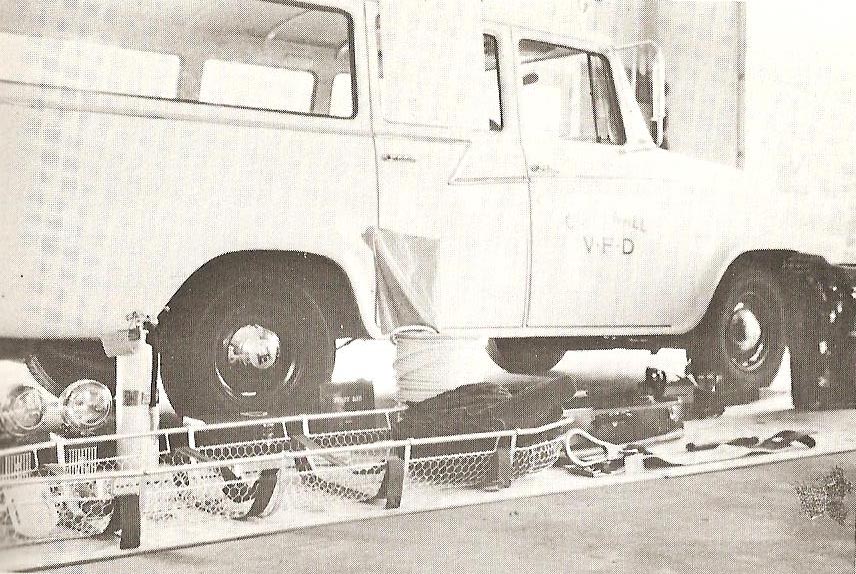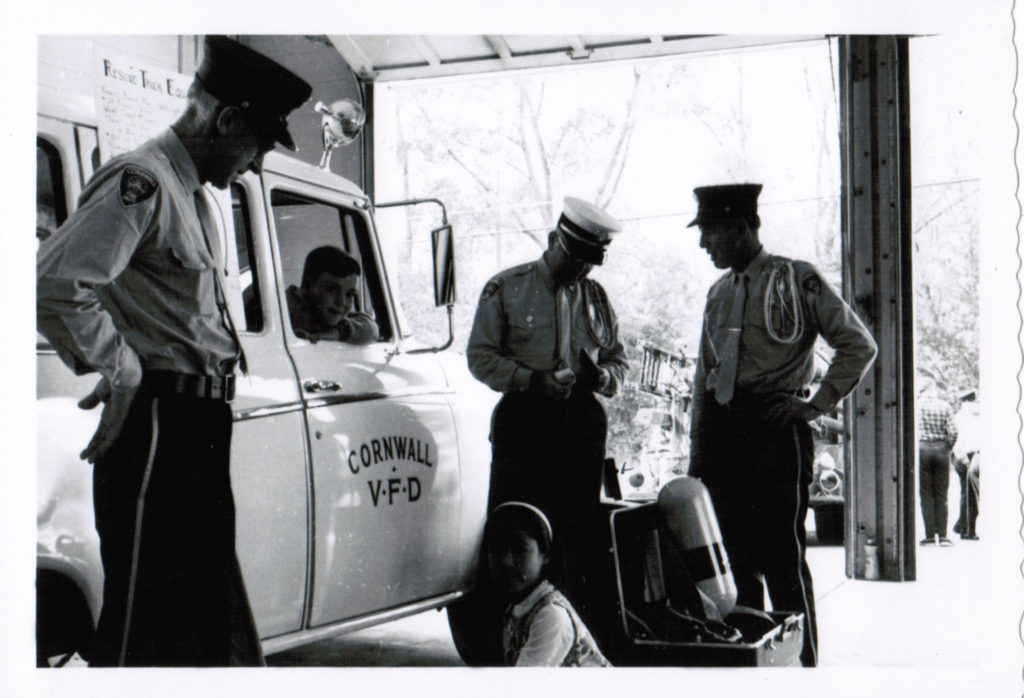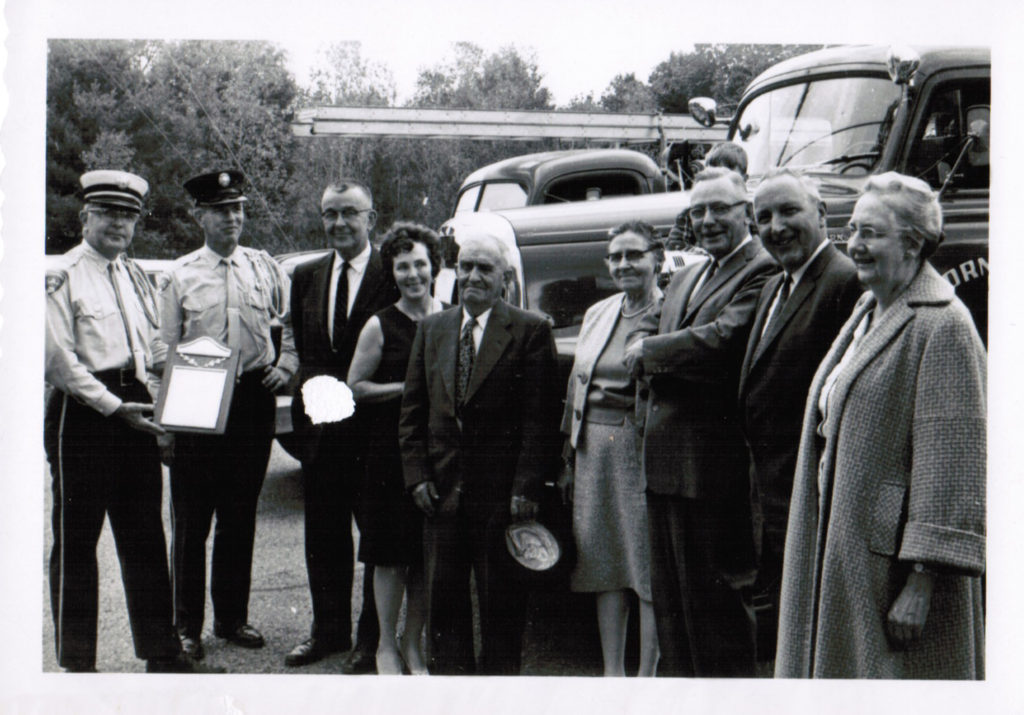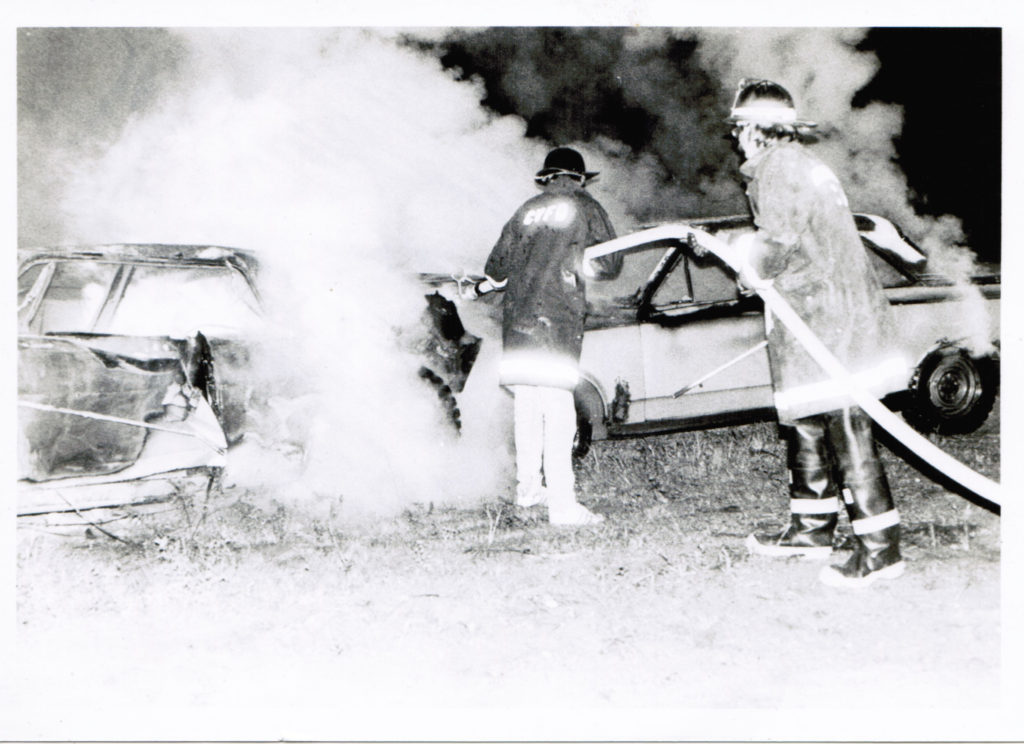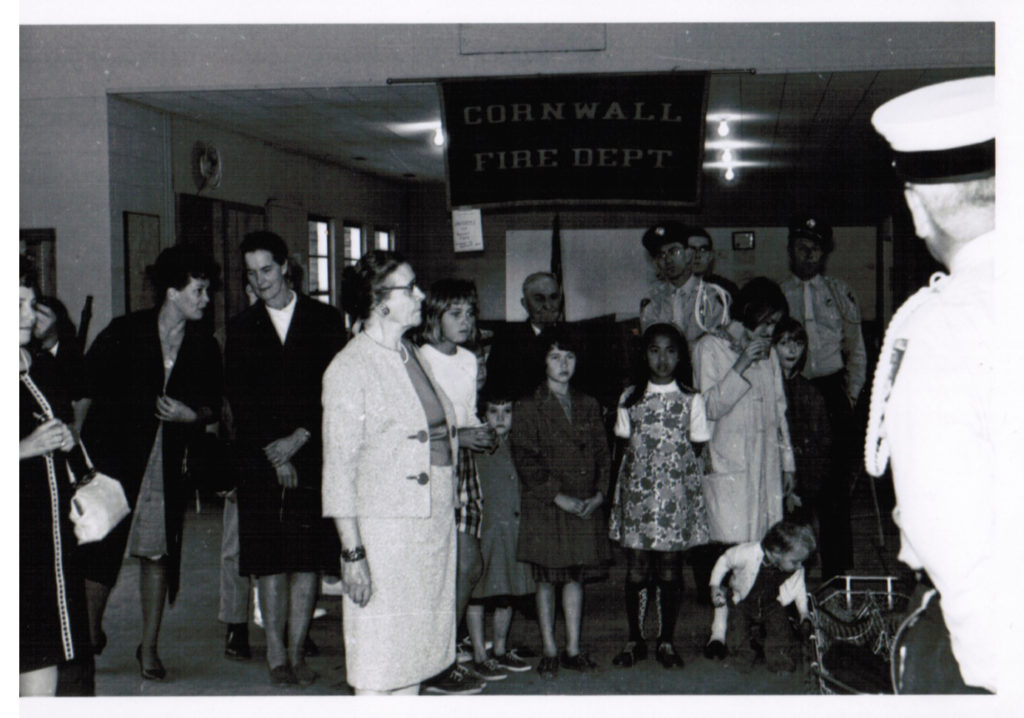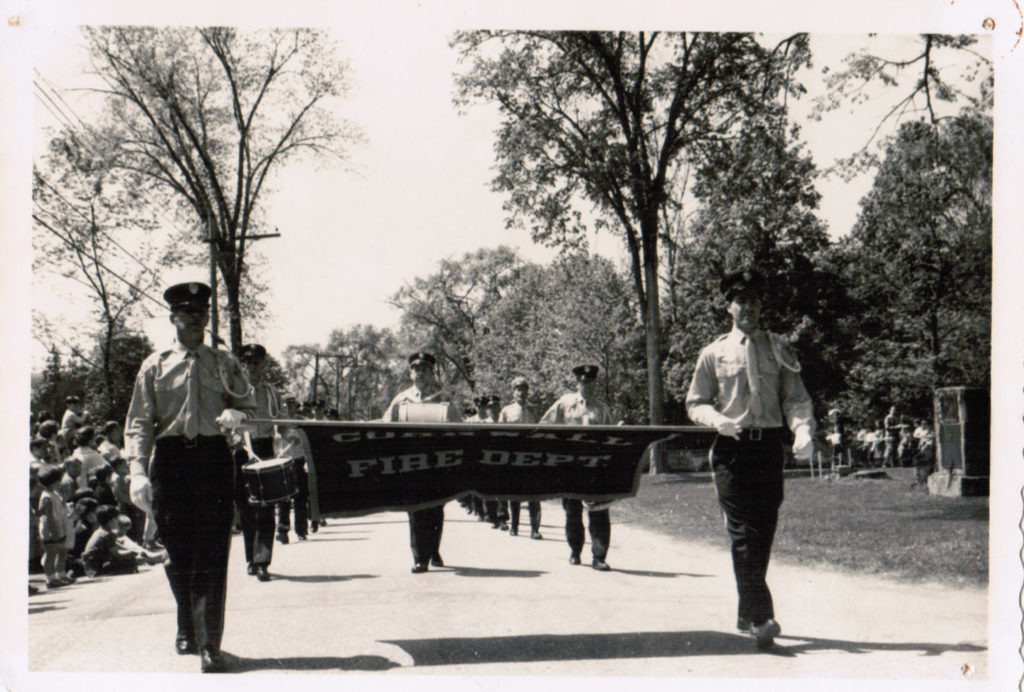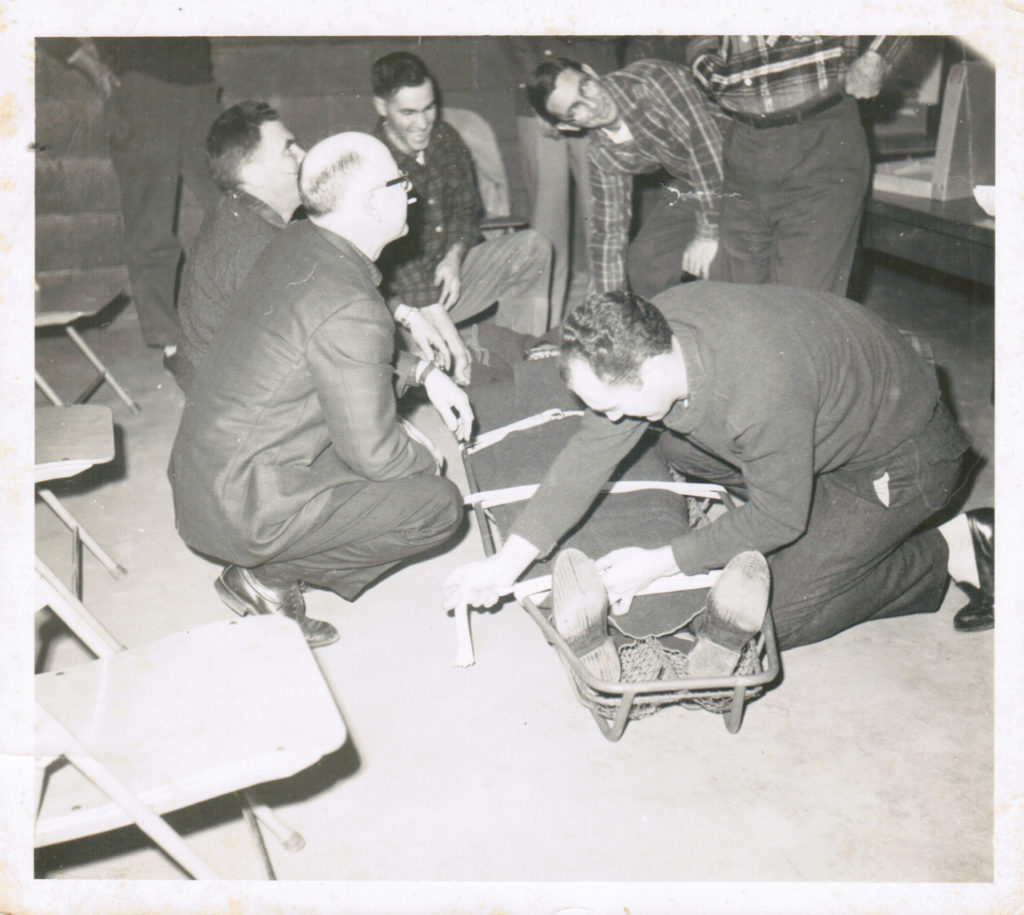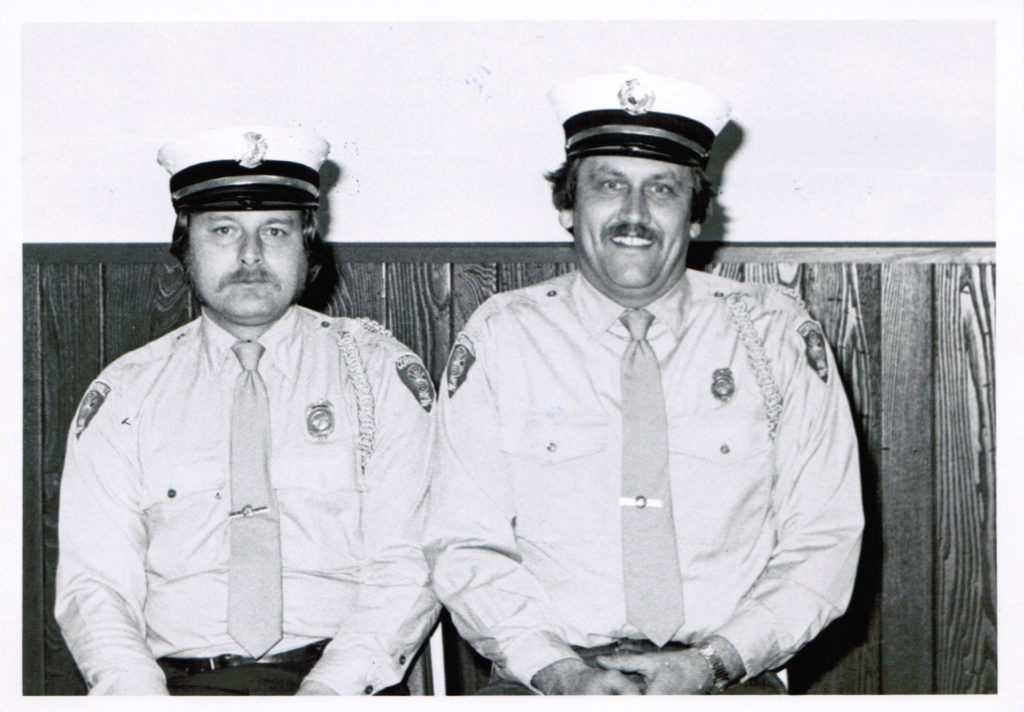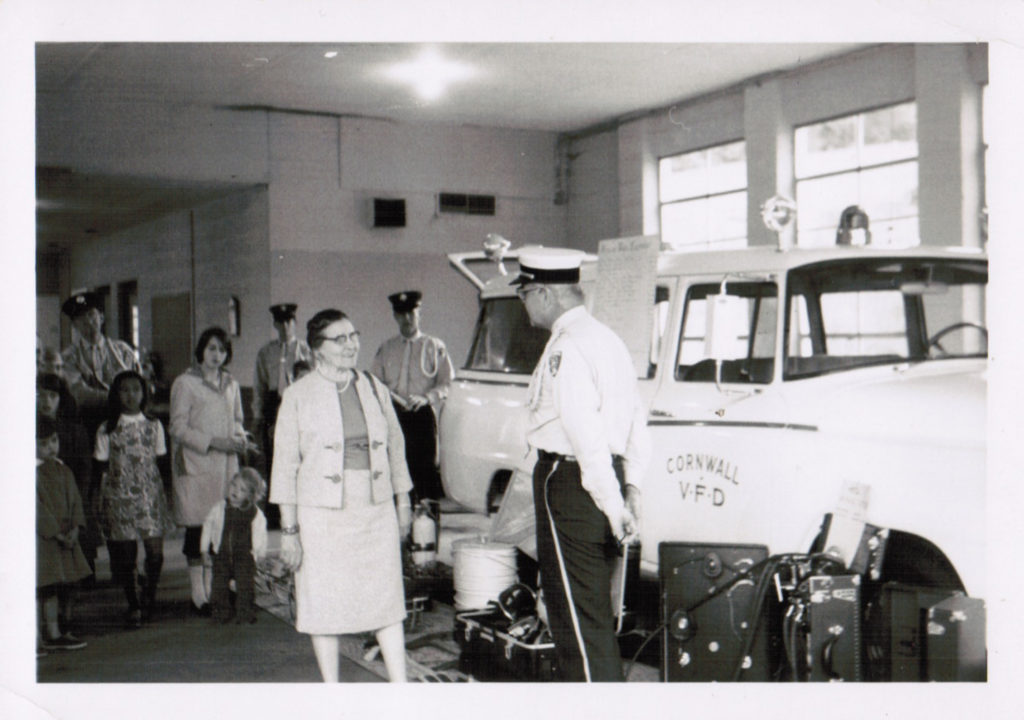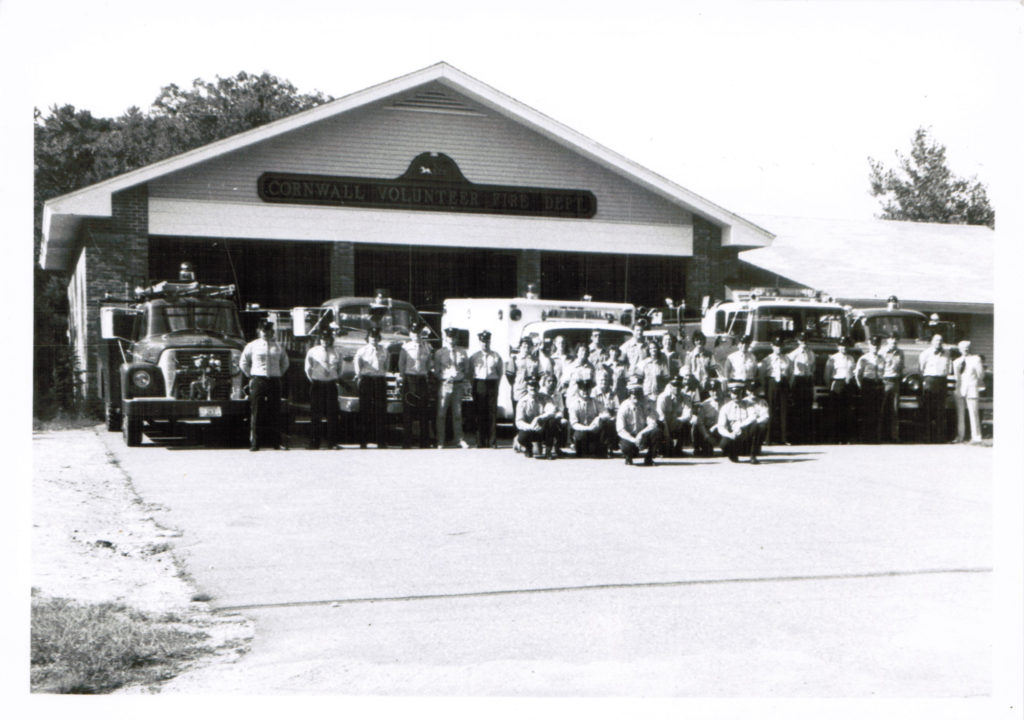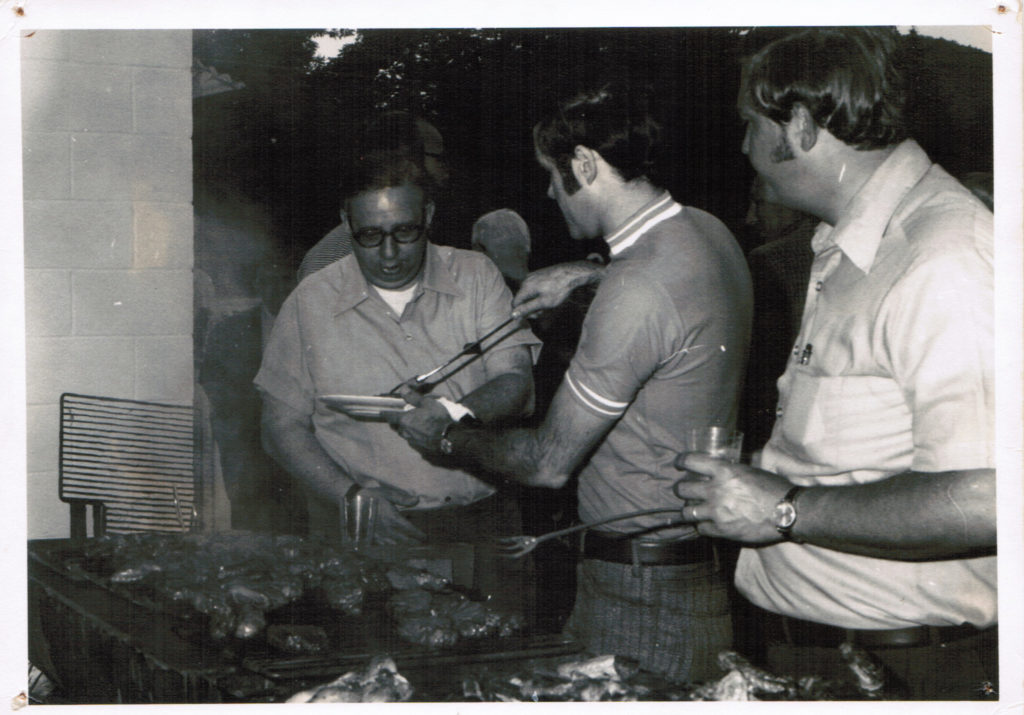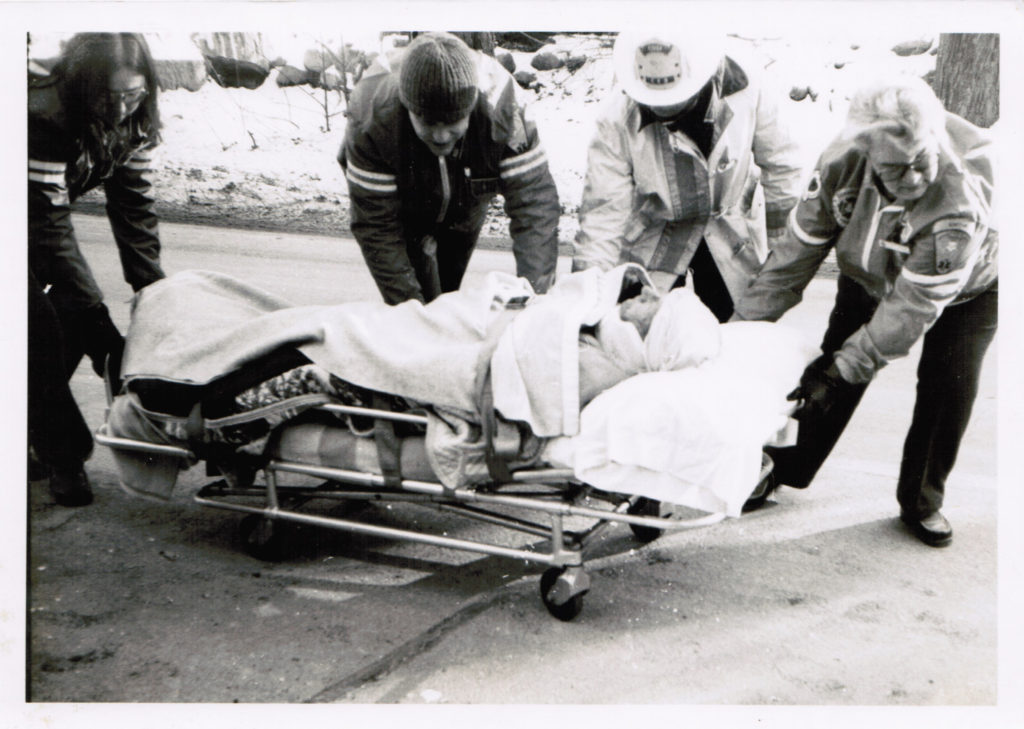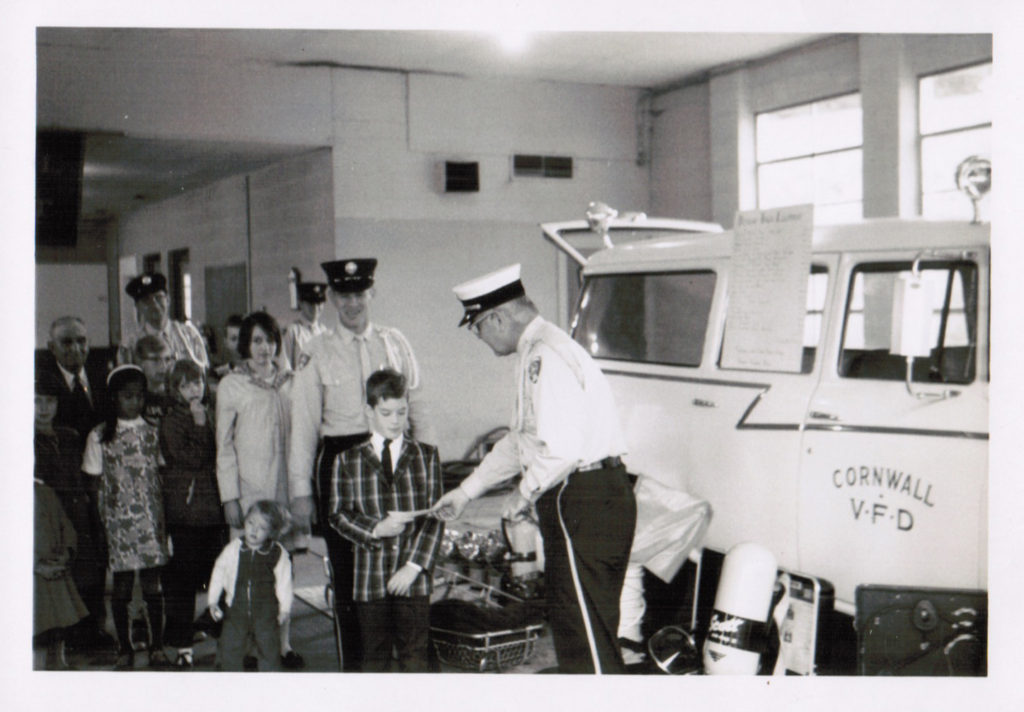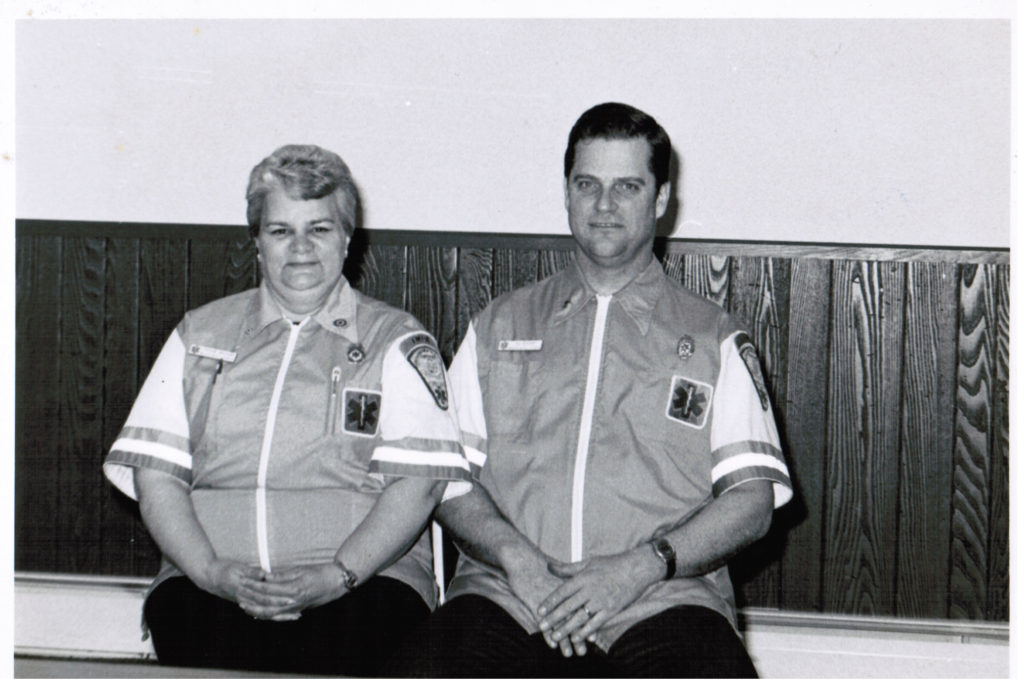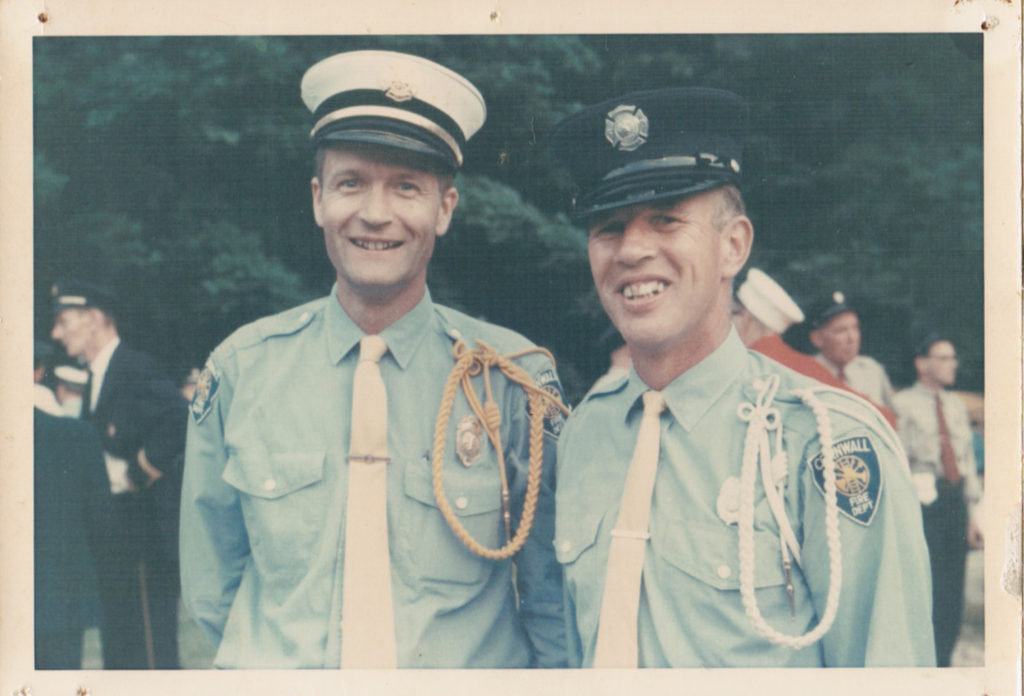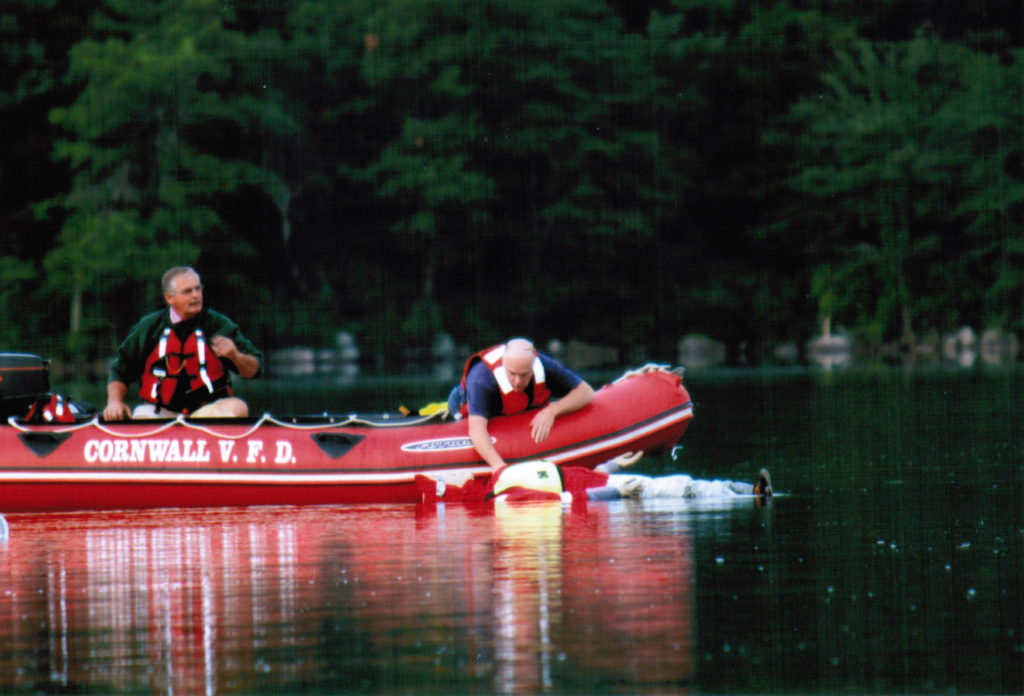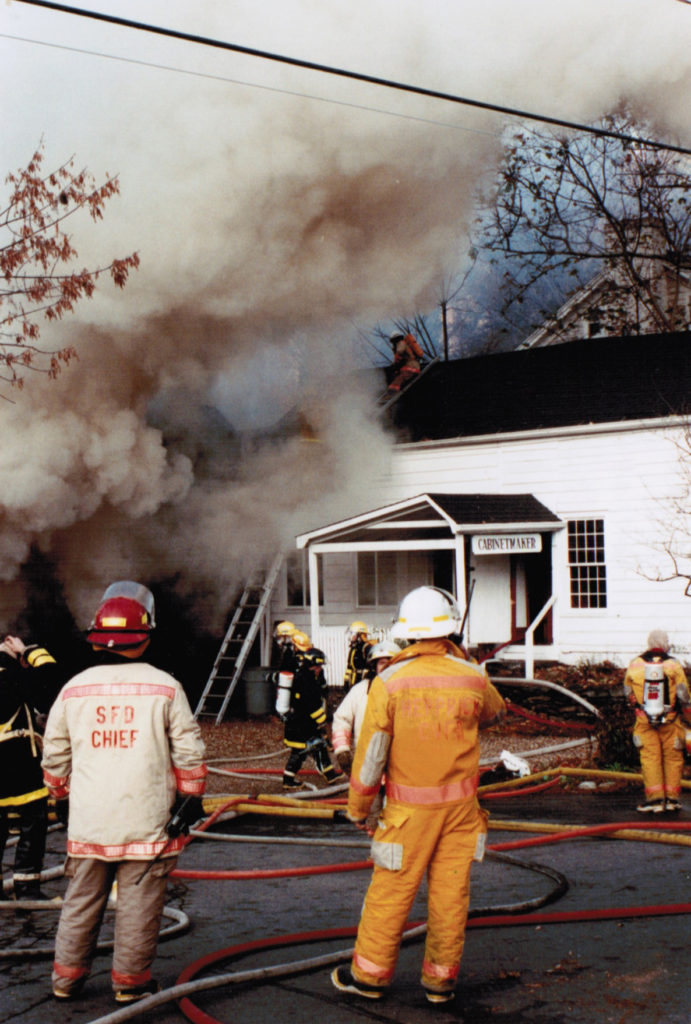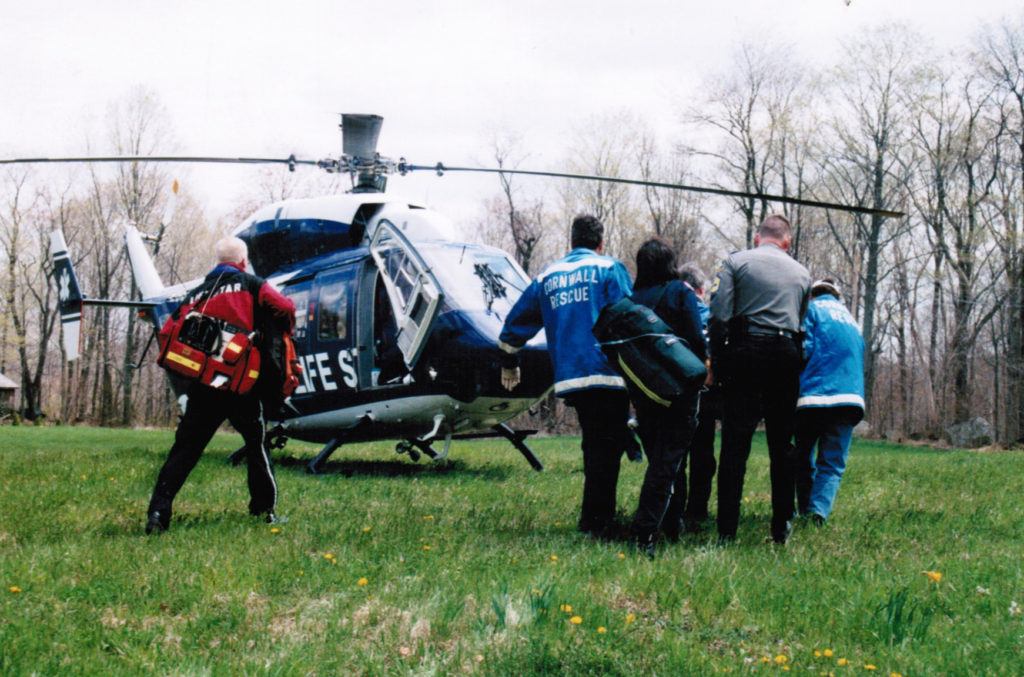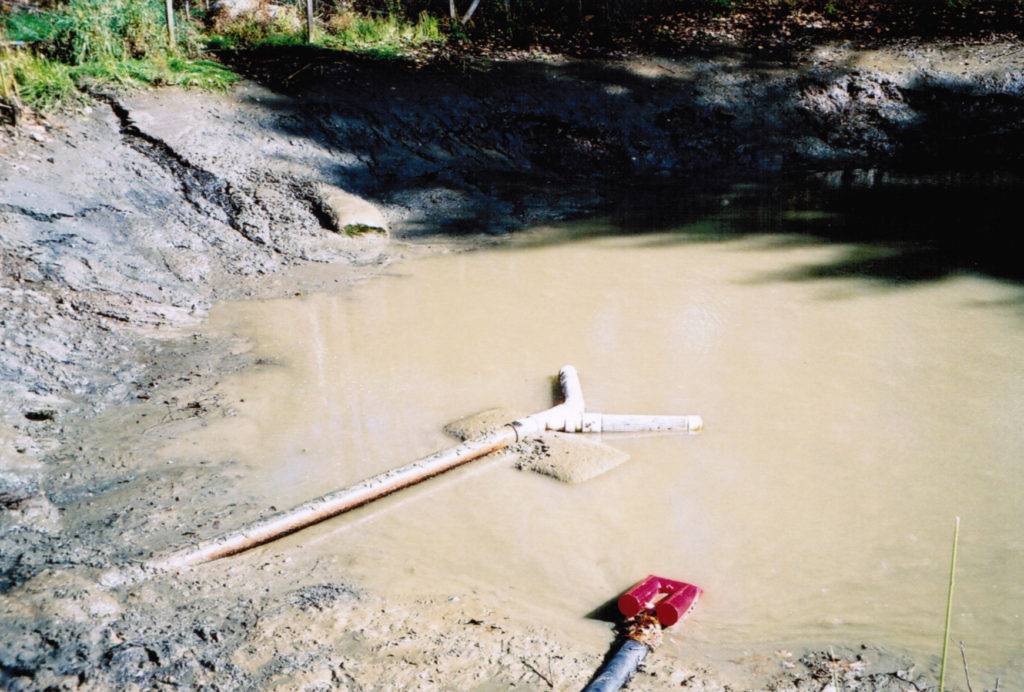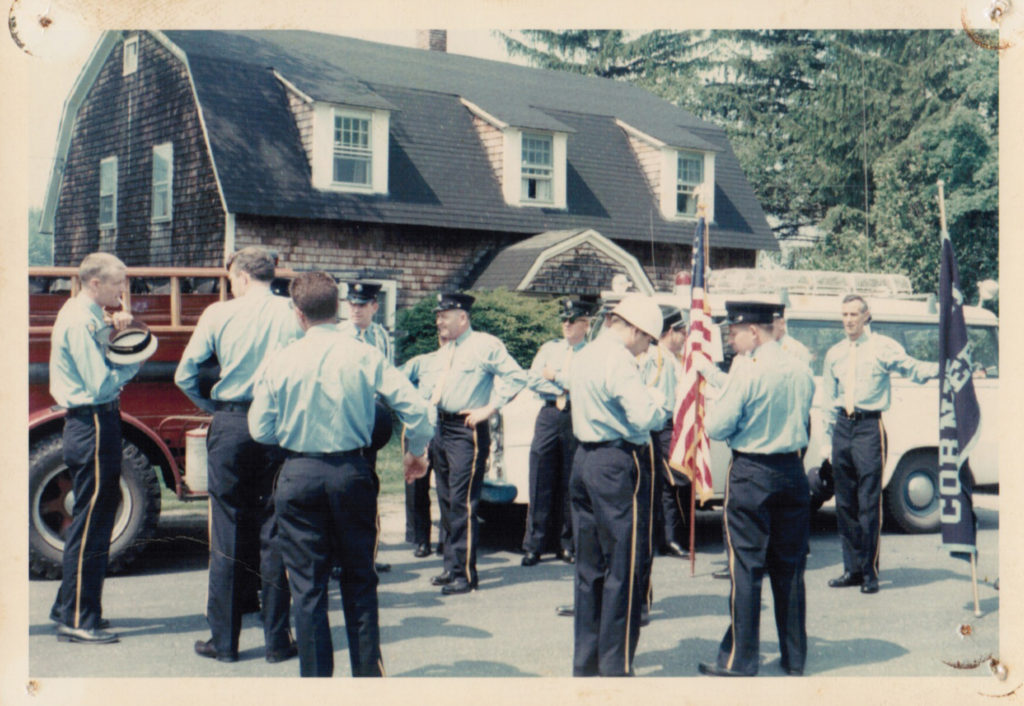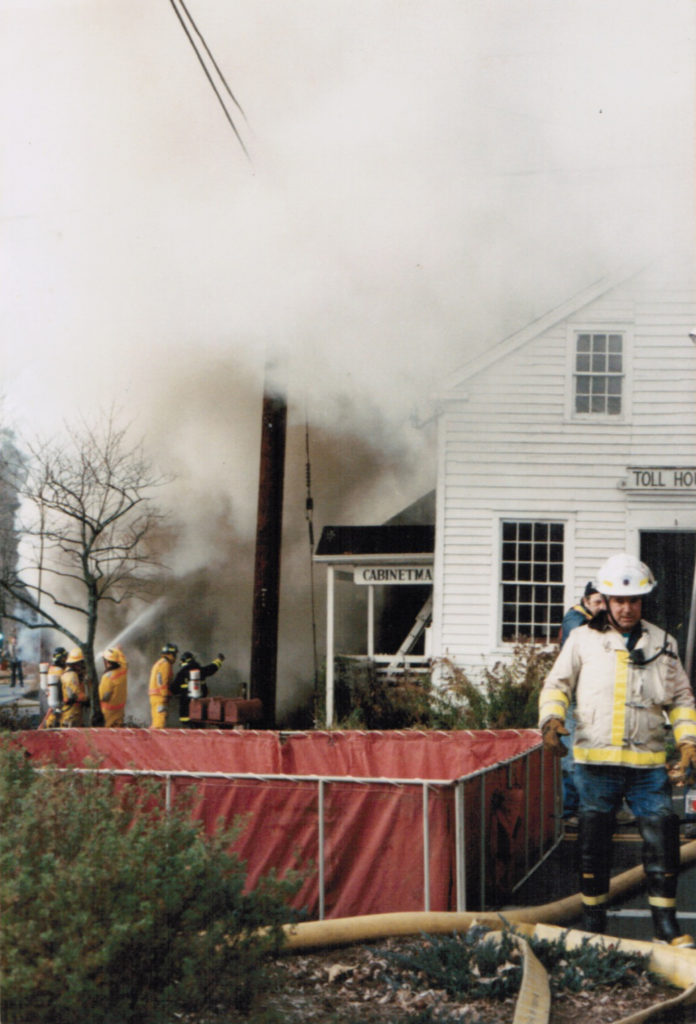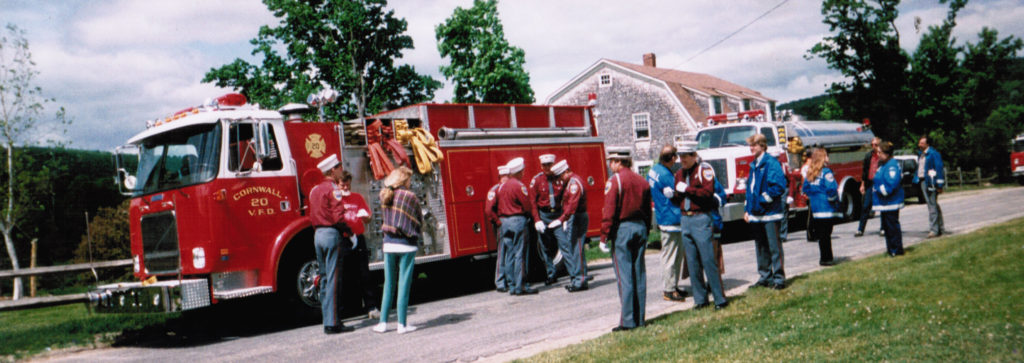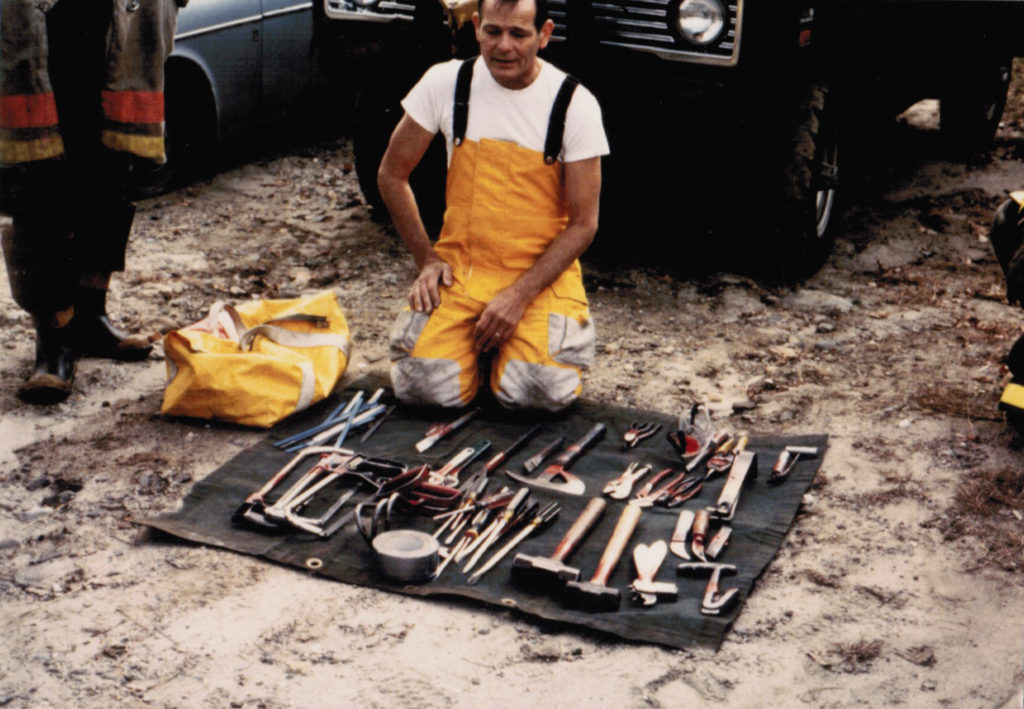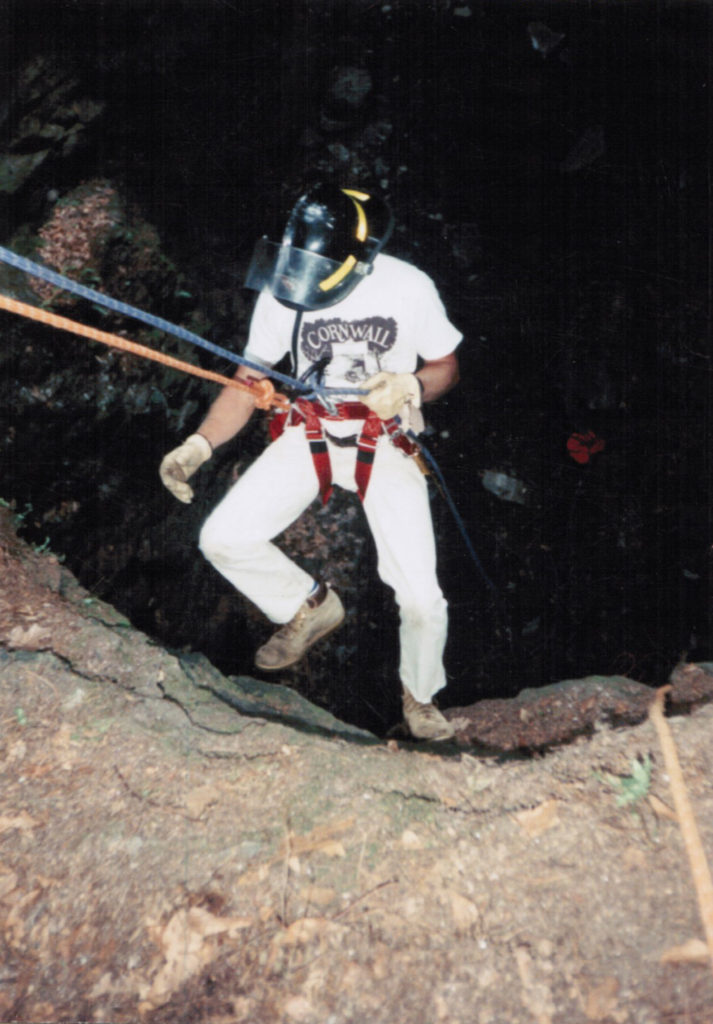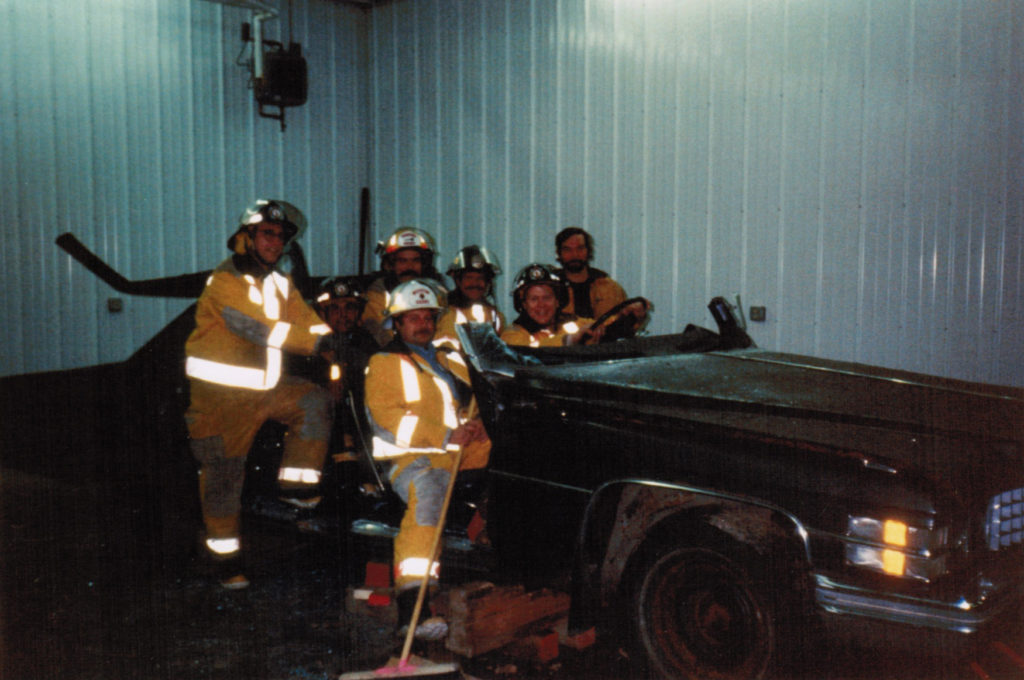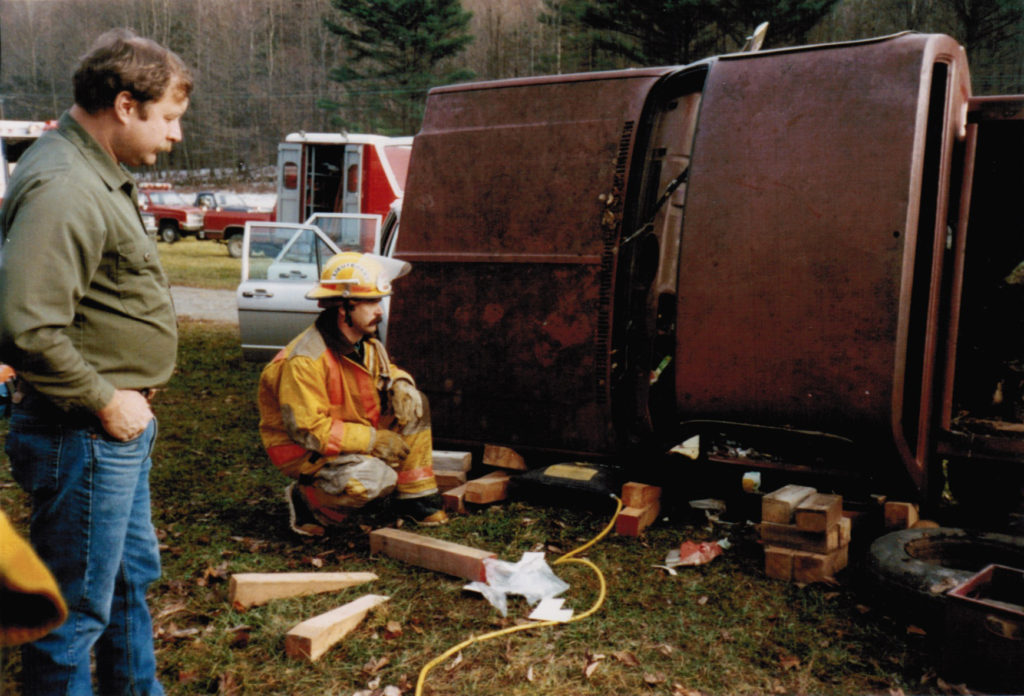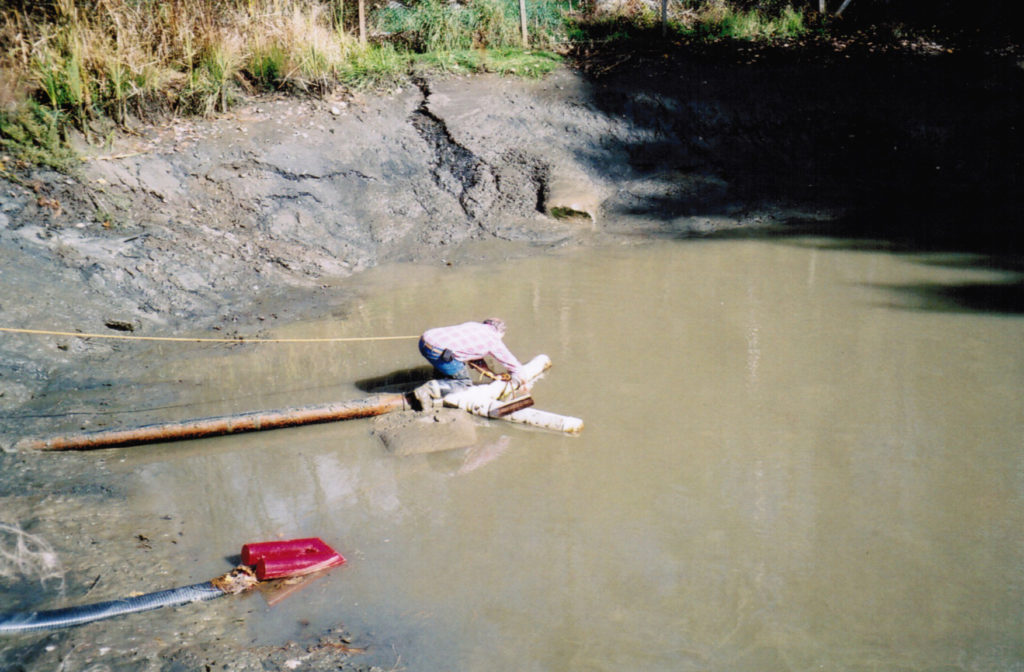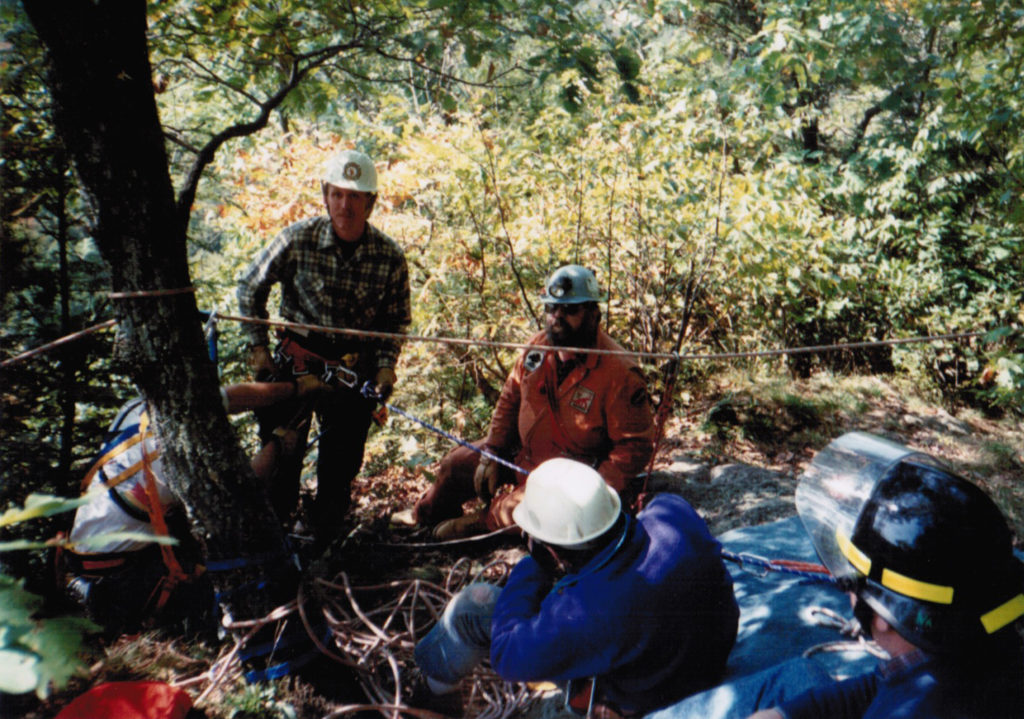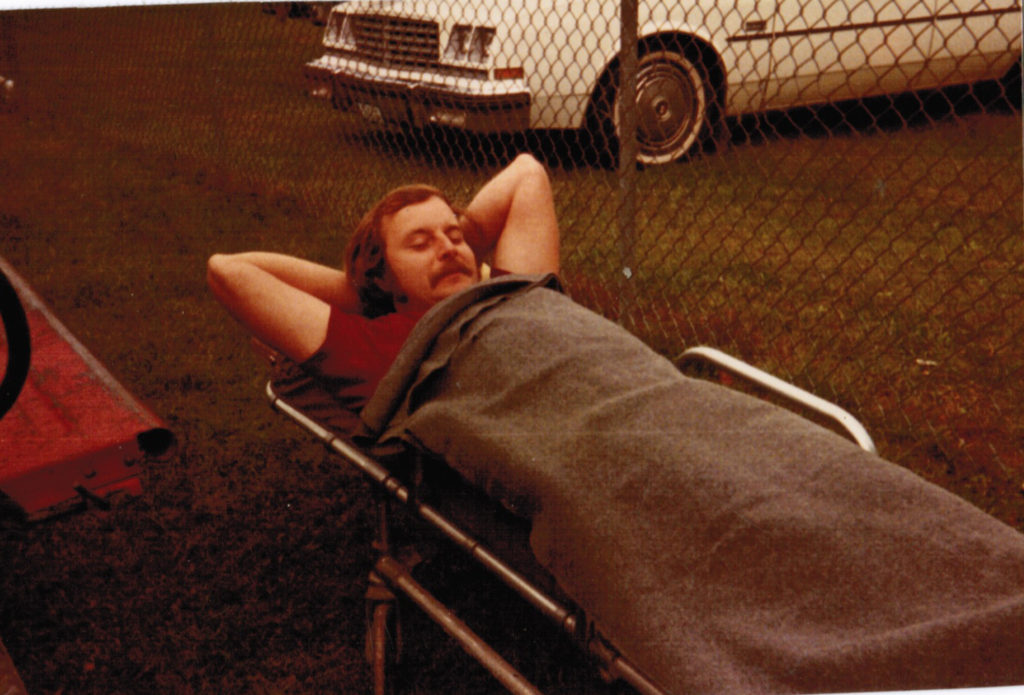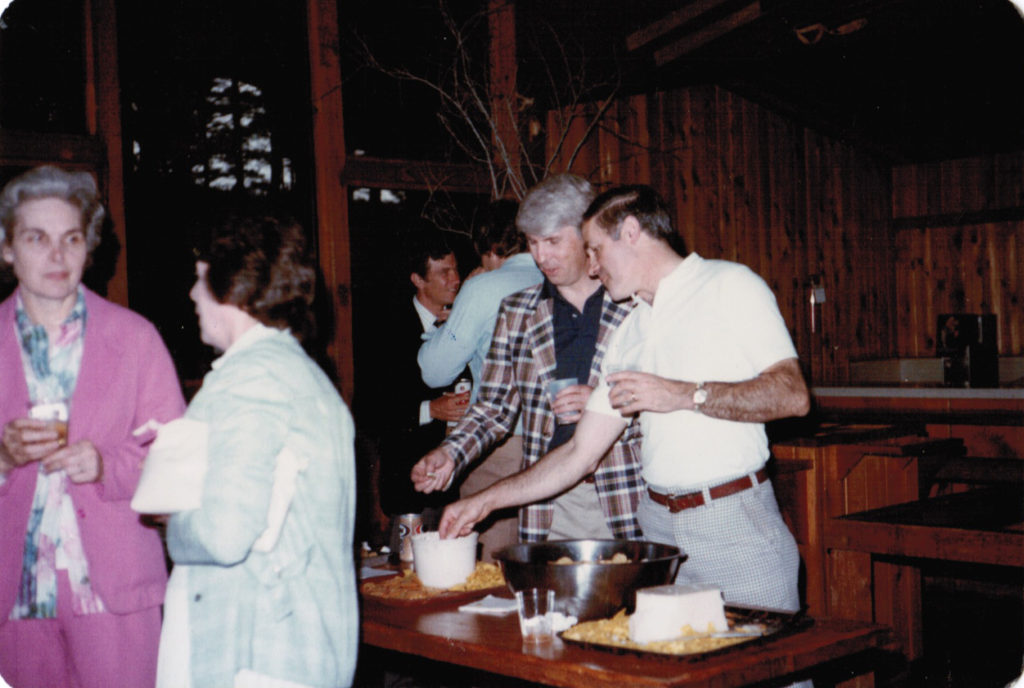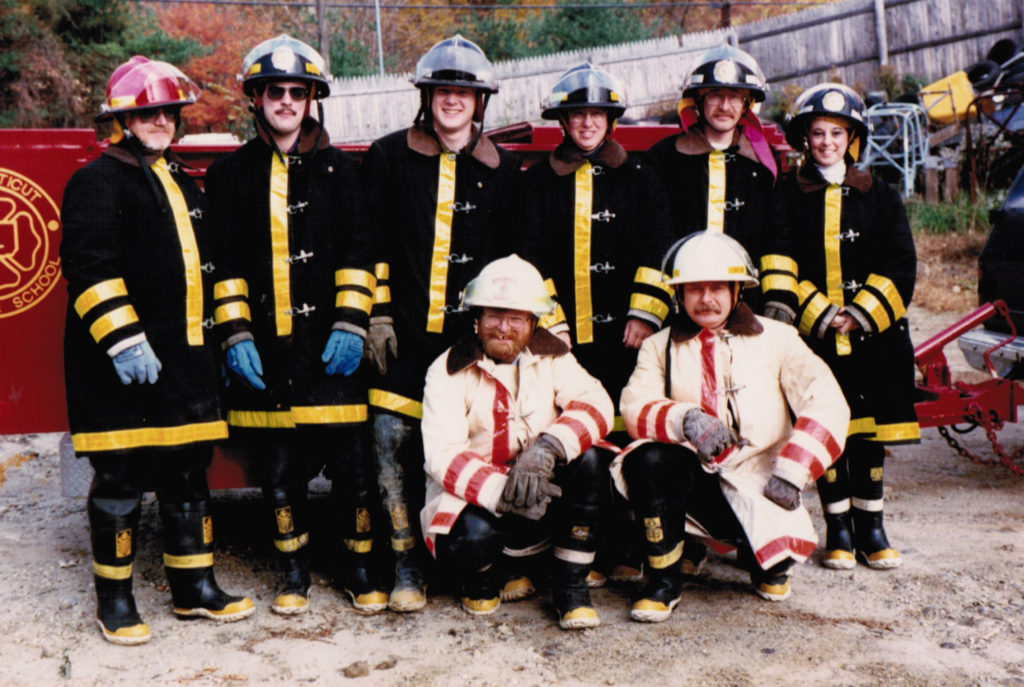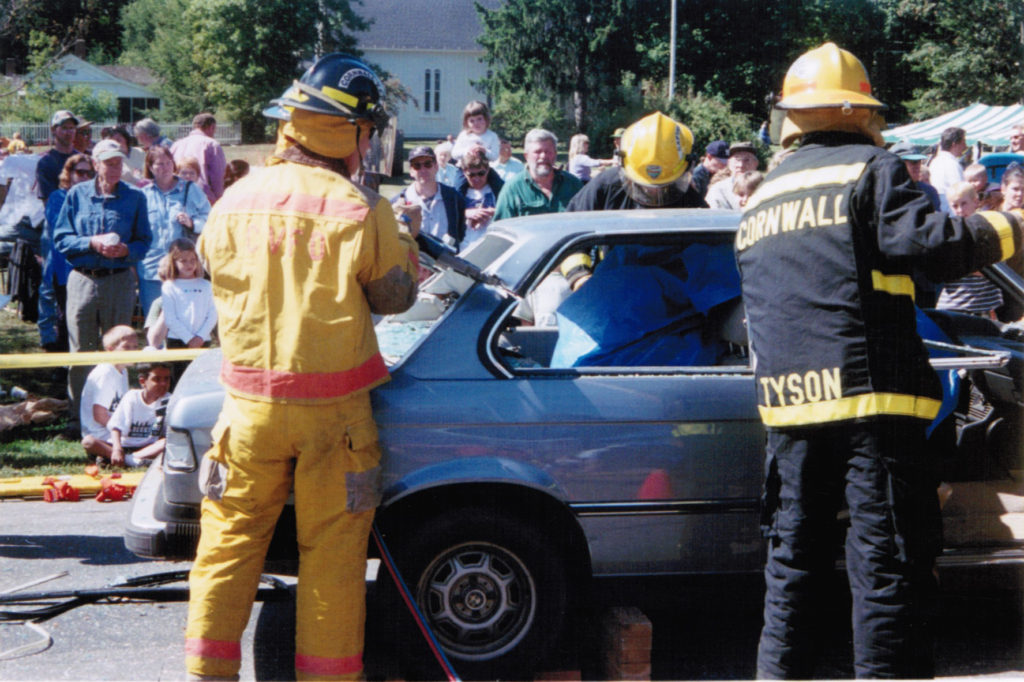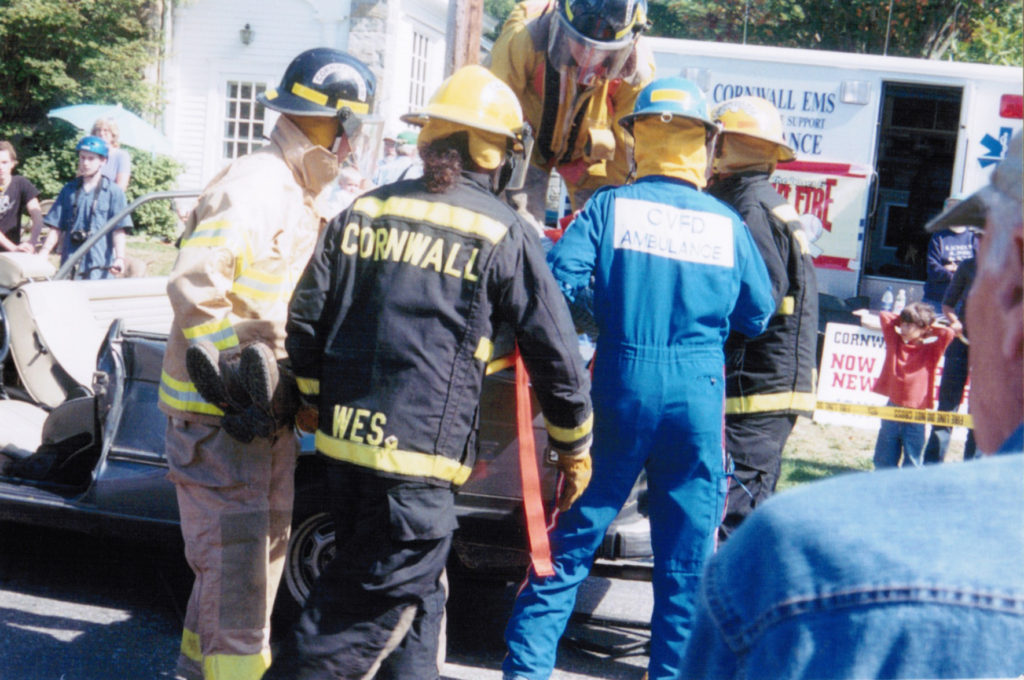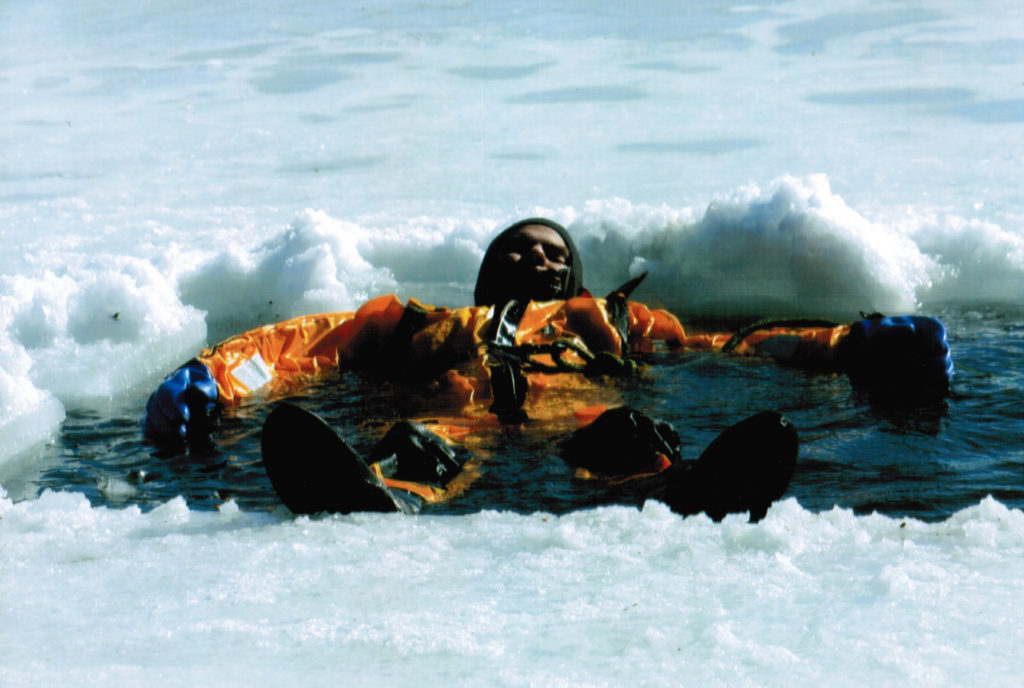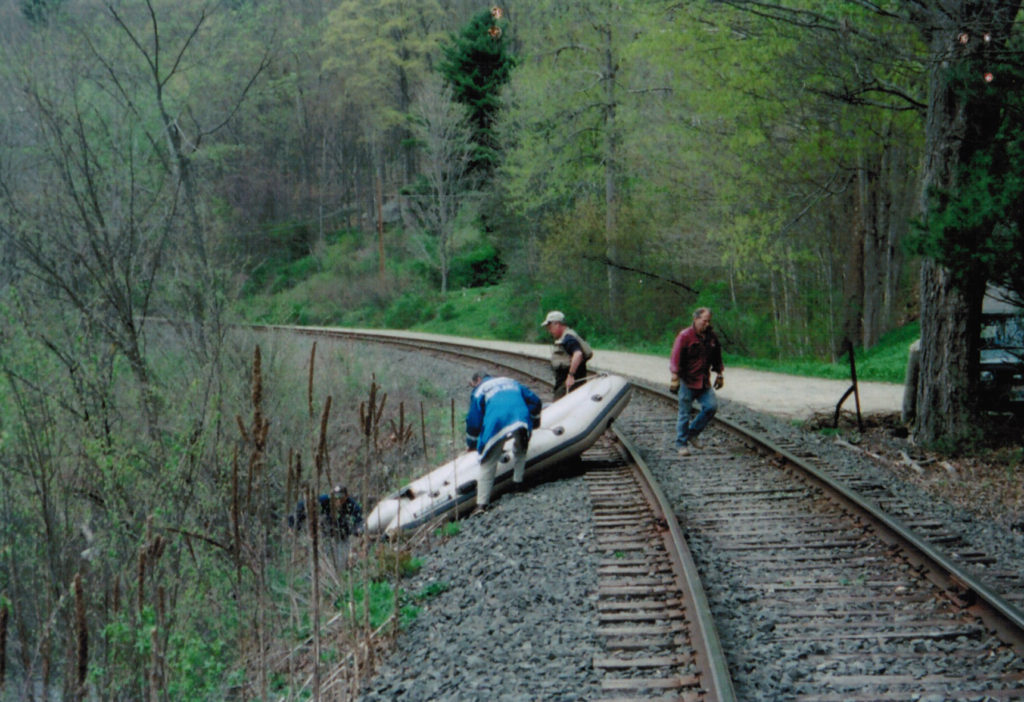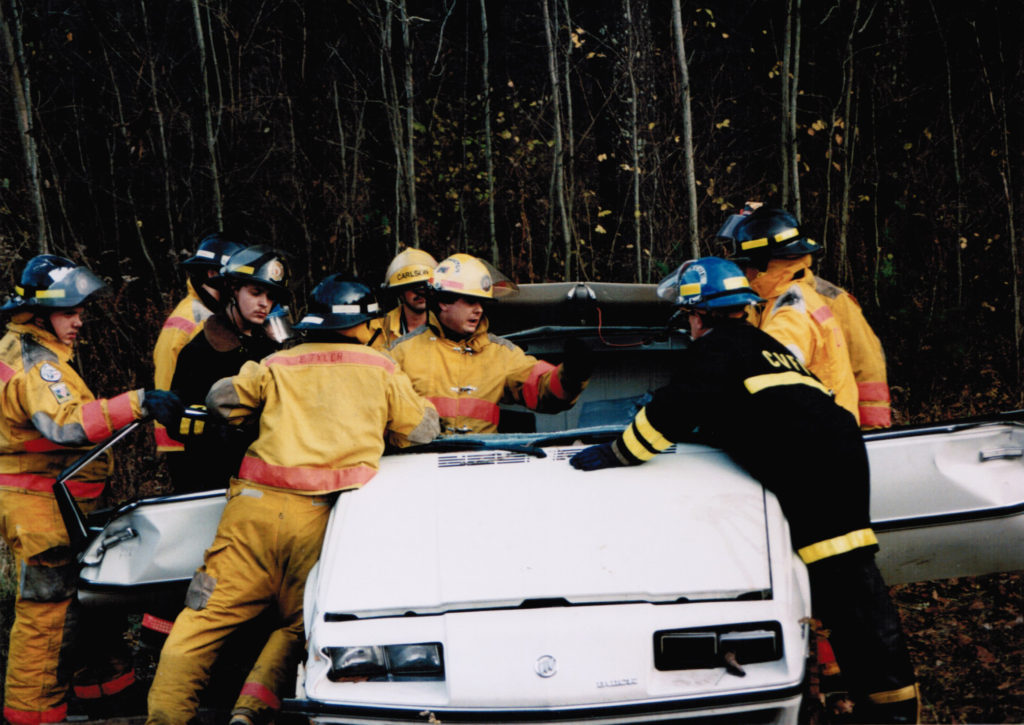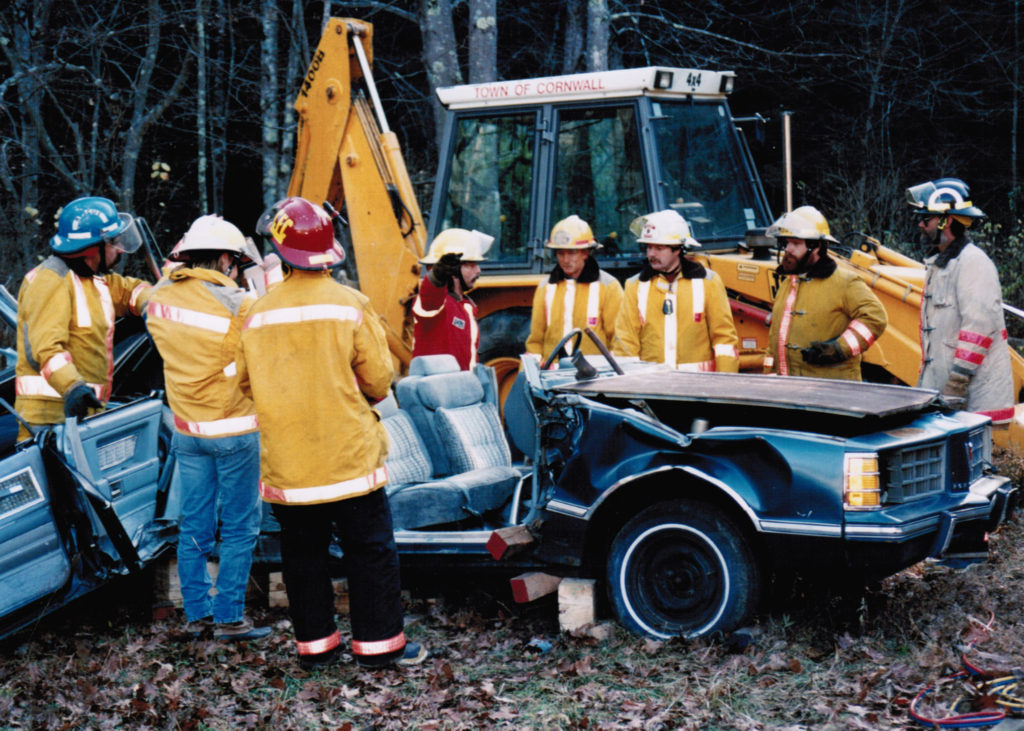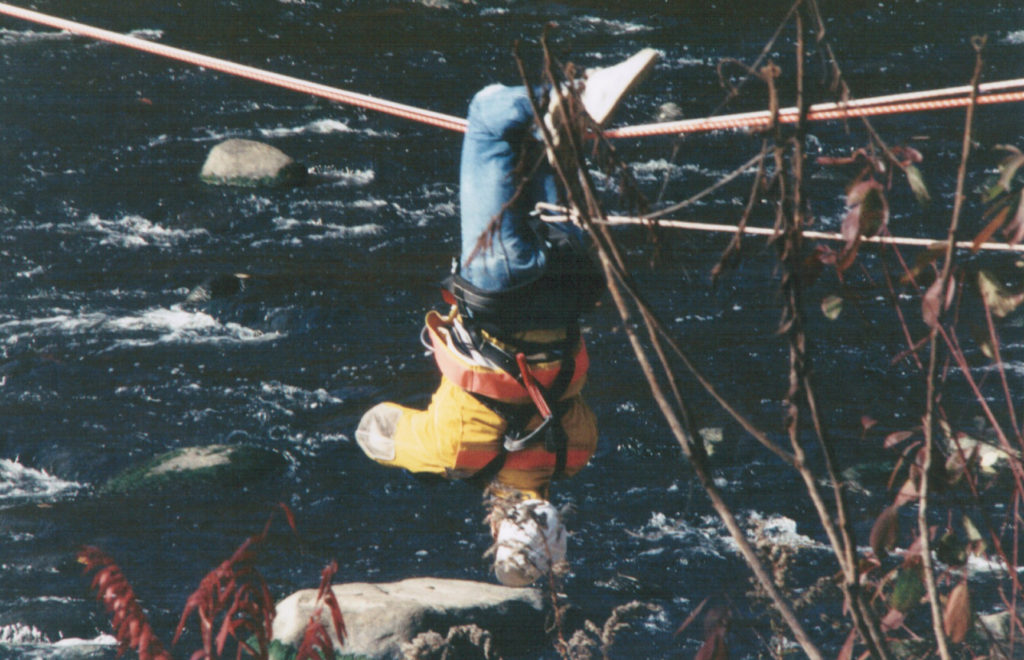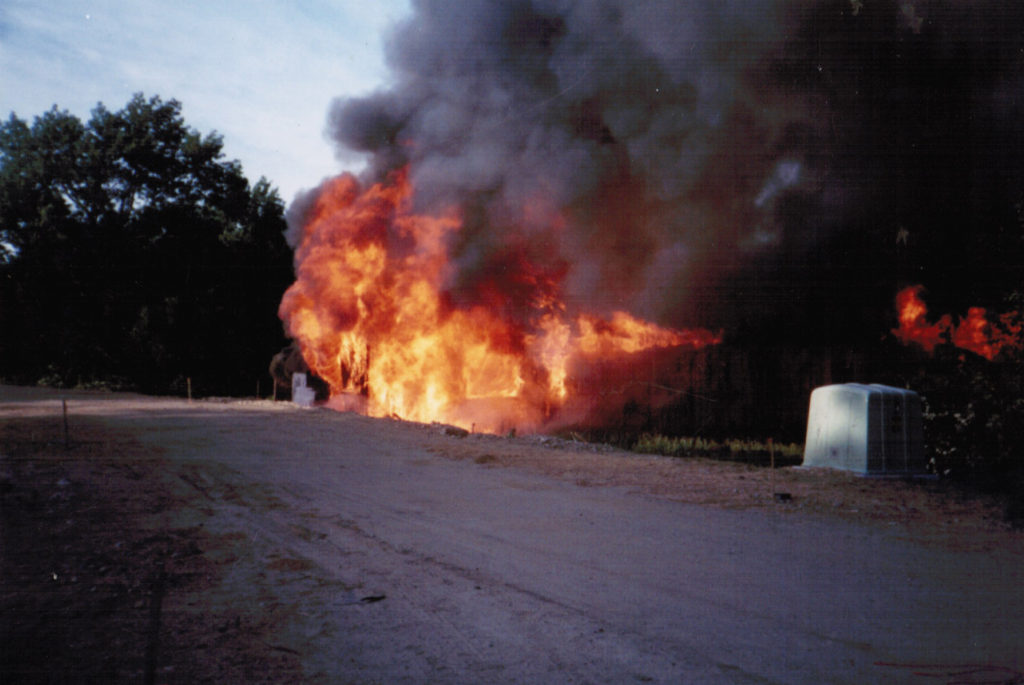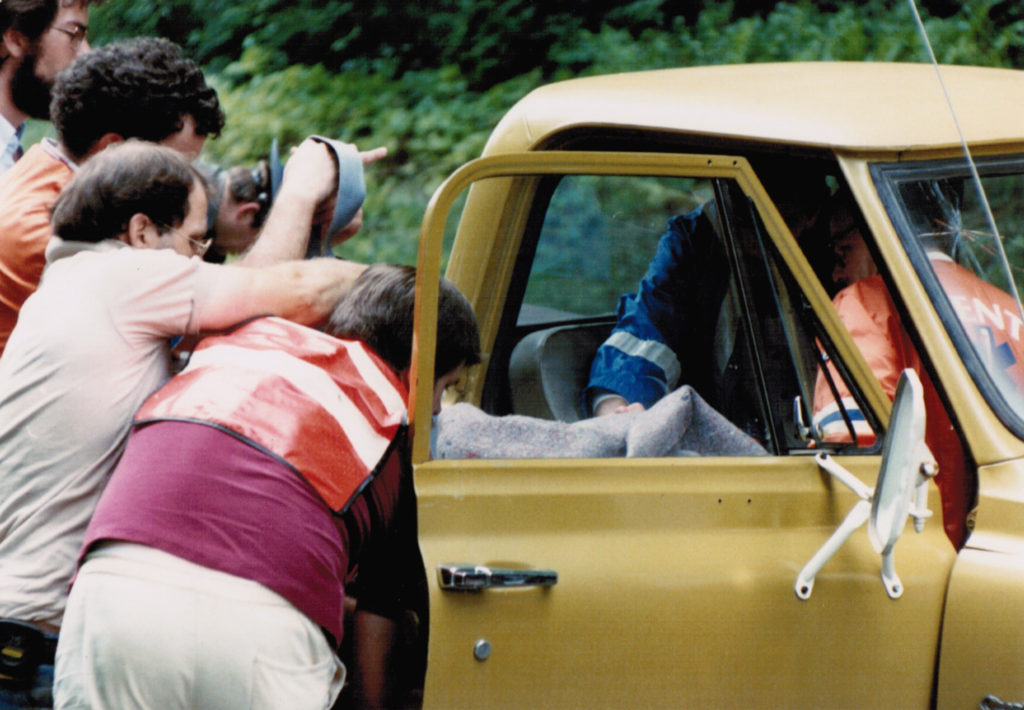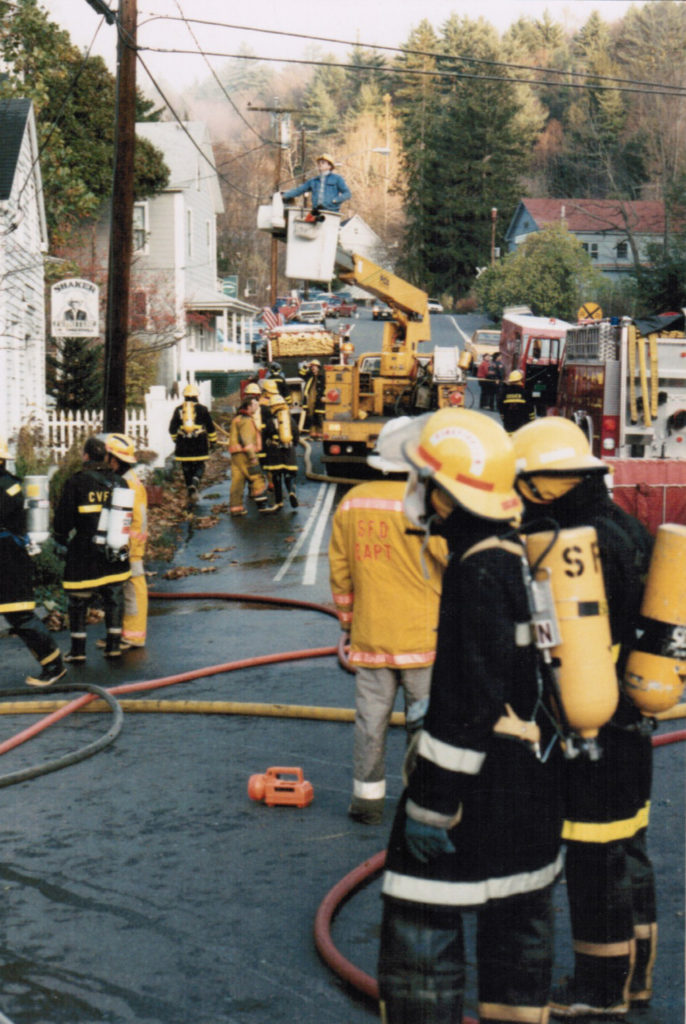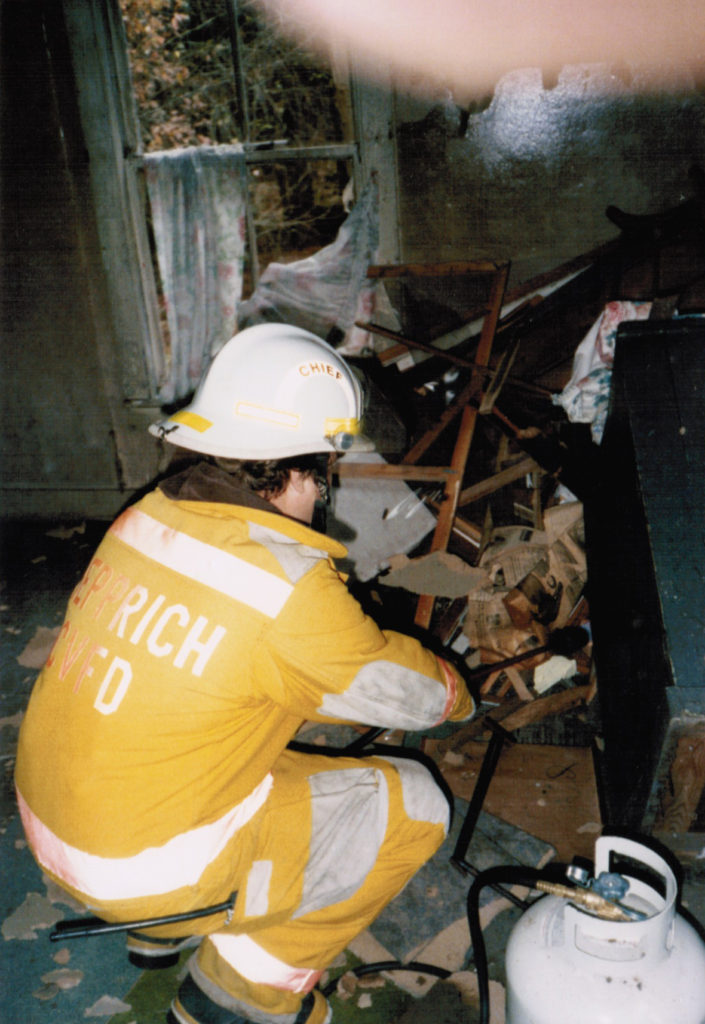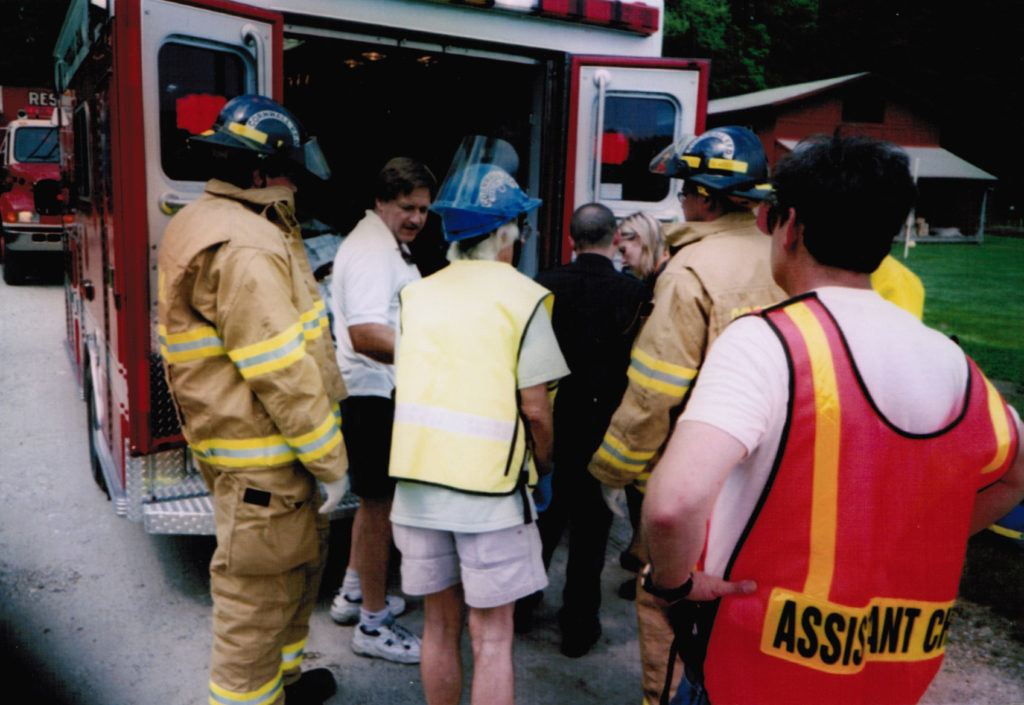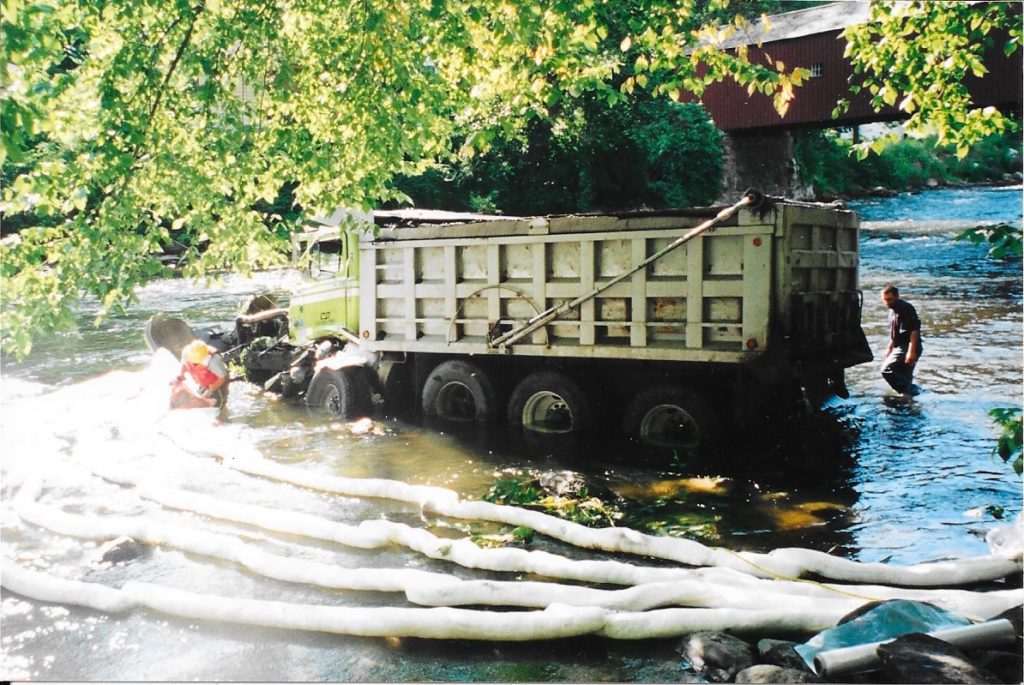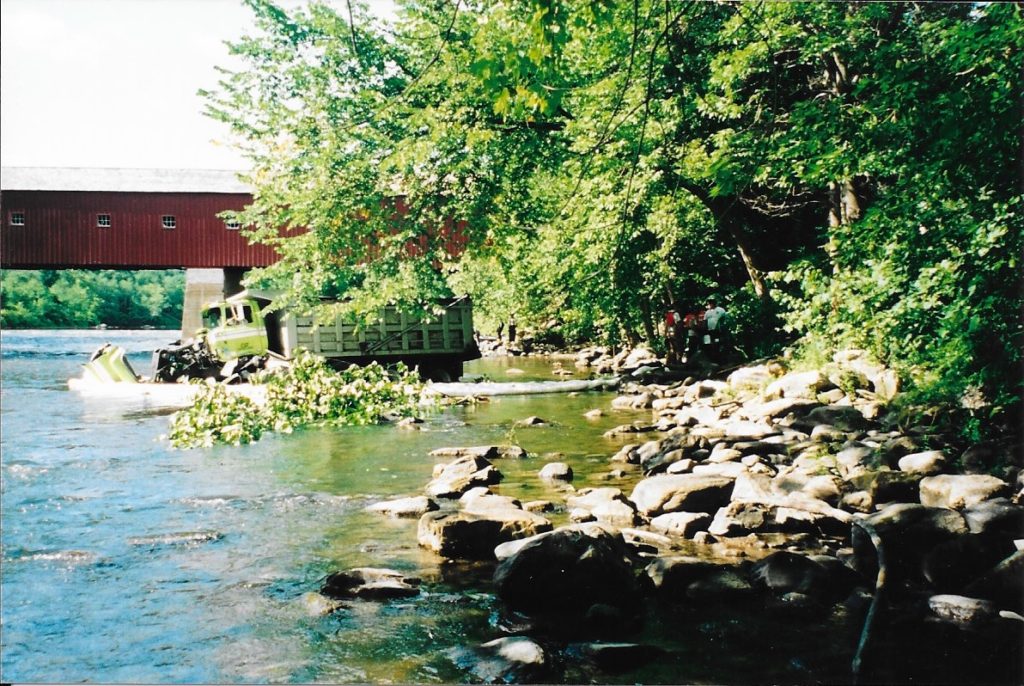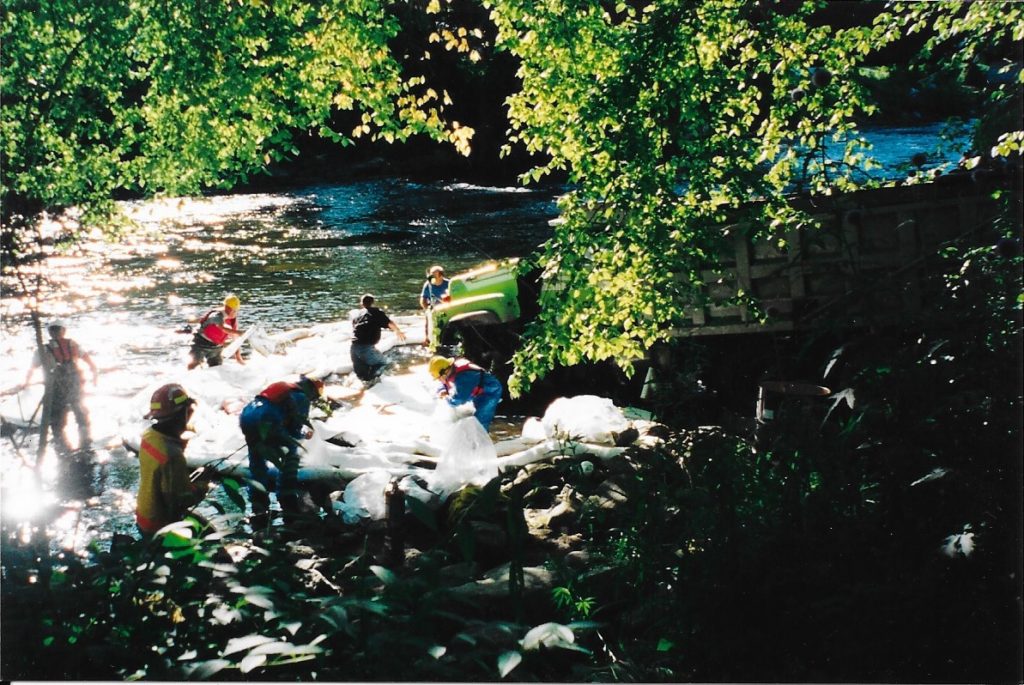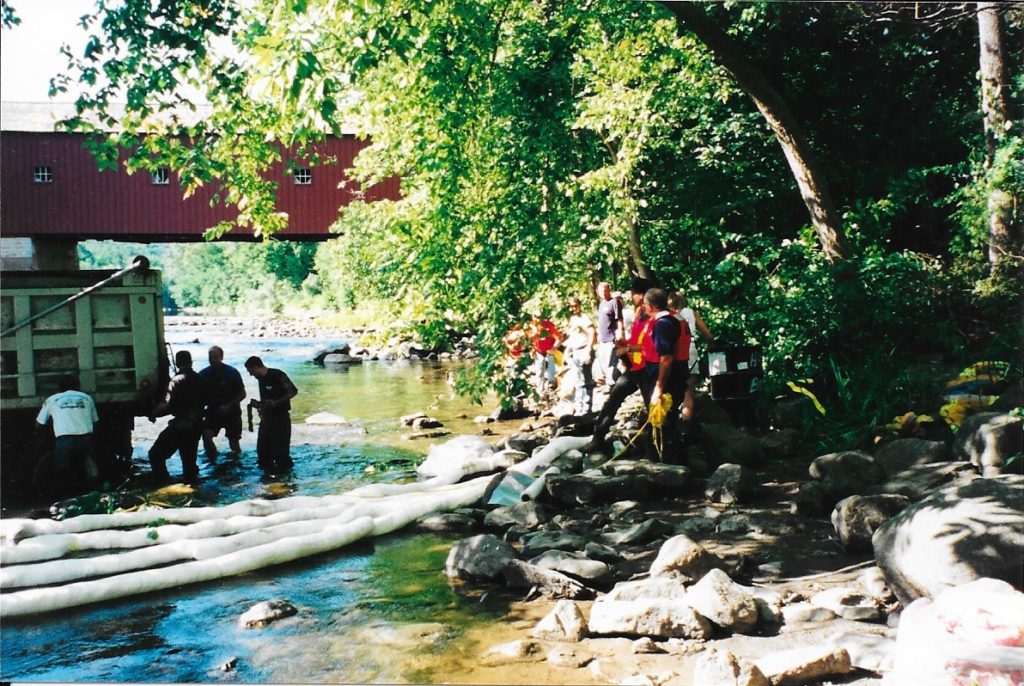THE CORNWALL VOLUNTEER FIRE DEPARTMENT
Ninety Years of Service
1932 – 2022
By
Edward M. Brecher
Casey Cook
On February 20. 1932, a fire broke out in a chimney at the farmhouse of Harrison Ives on Mohawk Mountain in East Cornwall. That same day, a similar fire broke out in a chimney at Major M. K. Lee’s Push-Em-Up Farm on River Road in West Cornwall. Chimney fires of this kind may do little damage – or they may spread to the beams, rafters, and roof; imperiling the entire structure. Neither of these fires were serious; yet they deserve to be remembered today, nearly a century later, for a special reason:
They were the first fires to be extinguished by the newly formed Cornwall Volunteer Fire Department.
During the nine decades since, the CVFD has extinguished more than 900 fires – an average of one fire for almost every residence in town. Only rarely has the fire got out of control and destroyed an entire structure; and even in such cases, the CVFD has prevented the fire from spreading to neighboring structures or woodland.
The years 1931 and 1932 were hardly an auspicious time to launch a new fire department, or any other new venture. It was the low point of the Great Depression, when businesses were going bankrupt and public services were being curtailed rather than expanded. Providing fire protection for an area as geographically extended and as thinly populated as Cornwall, moreover, involved enormous difficulties. The town’s 361 dwelling houses were spread out over 31,000 acres—an average of 7.4 dwellings per square mile. Umpteen miles separated the northeast from the southwest corners-of the town, and many miles of roads crisscrossed it. Few miles were improved in 1931 – barely passable in muddy weather and in winter. The hills were steep, the winters bitter cold, and very few homes had an adequate supply of water within pumping distance. The town population, moreover, was only 878 (1930 census), — including only a modest number of able-bodied men available on any given day or night for fire duty. These are the kinds of obstacles the CVFD has had to face and overcome year after year through the past half-century.
The Cornwall Hose Company
An earlier effort to supply fire protection to a limited area within the town had been launched in 1916 but had only partial success. Cornwall in 1916 was composed of three villages – West Cornwall, Cornwall Bridge, and Cornwall, the latter known also as Cornwall Plains, Cornwall proper, or Cornwall Village. Each of the three villages had its own school, its own post office, its own church or churches, and its own local pride. Surrounding the three villages were neighborhoods known variously as East Cornwall, North Cornwall, South Cornwall, Warren Hill, Cornwall Hollow, Cornwall Center, and so on. Only Cornwall Village had a central water supply, reaching 30 or 40 dwellings through pipes laid down in 1916 by the Cornwall Water Company. This water company had been founded by a public-spirited resident of Cornwall, John Richter, who had cited fire protection as one of the reasons why village residents should invest in a village water system. Once the pipes (and two fire hydrants) were installed, John Richter went on to organize the Cornwall Hose Company as well. Here are the minutes of the first meeting of the hose company: “At a meeting called in the interest of a Cornwall Fire Co. Jan. 6, 1916, Mr. Richter called the meeting to order. Mr. Loucks was appointed chairman and Mr. Marsh, Secretary (pro tem). After a discussion of ways and means, Mr. Richter was chosen Foreman of said company, and Walter Carlson as Assistant Foreman; Thomas Bate, Secretary and Treasurer. Trustees appointed for one year were J.E. Calhoun, F.A. Loucks, and C.C. Marsh. Mr. Richter presented the Company with a Hose Cart, and Mr. Loucks accepted same on behalf of the trustees. Mr. Calhoun promised to put up a building for same. Mr. Richter was asked to circulate a paper to get subscriptions for 500ft. hose. Voted to close the meeting.” At a second meeting three weeks later, Foreman Richter reported that he had raised $190 to buy fire hose – a substantial sum in those days, but not enough. Hence there was “discussion of dance to raise balance of money to pay for hose” – a method of fund-raising that the Cornwall Volunteer Fire Department continues to use to this day. The following year, a second dance was held “to buy two extension ladders, two Axes, three lanterns, and a Jimmy.” The company’s hose cart, let it here be noted, had no means of self-propulsion. It was hauled to fires by firemen on foot. The minutes of the Cornwall Hose Company’s 1918 meeting give the flavor of this modest early effort to provide fire protection: “Discussion of how fire started at Rumsey Hall (now Marvelwood School). No one seemed to know. How did fire start at Mrs. Farnum’s? No one knows. Voted to buy three Respirators and one set of Goggles, to enable one to go into thick smoke. “Discussion of whether members pay a small yearly dues. Voted that each member pay 50 cents a year, if he cares to. The money to be used as the Company sees fit.” Communications were a problem in the hose company days as in later decades. The first telephones were installed in Cornwall in 1912; and many residences still lacked phones in 1916. In case of fire, firemen were commonly summoned by ringing the bell at the Fire House and by knocking on their doors. Minutes dated September 18, 1920, suggests the shortcomings of this system: “Alfred Catlin’s garage burned about 12 o’clock at night. Several of the Firemen responded to the alarm, but the building and contents were destroyed.” One year later, the hose company had better luck. It “responded to a call of fire at Rumsey Hall about seven o’clock in the evening. The company were all present, and the fire was promptly extinguished … The damage was estimated at $1,500. Mrs. Sanford extended hearty thanks to everyone who helped at the fire. Many were present from West Cornwall and Cornwall Bridge.” After 1921, however, the Cornwall Hose Company became less active. No meetings were held or records kept from October 1921 until November 21, 1928, when the following minutes were recorded: “The seventh meeting of the Cornwall Hose Company was held on the above date at the Chapel. John Richter resigned as Foreman of the Cornwall Hose Co., his health not permitting him to continue in the office any longer. His resignation was accepted and he was given a rousing vote of thanks for his long years of service to the company, and his help in starting the company in 1916. There being no further business, the meeting adjourned. Wm. H. Snyder, Sec. & Tres.”
Founding the CVFD
That was the beginning of the end of the Cornwall Hose Company. The CVFD was to take its place three years later. During the interim, there were many reminders of the urgent need for fire protection. The most awesome of these occurred on May 3, 1930, when a brush fire originating on Mt. Riga in nearby Salisbury, Connecticut, spread northward into Massachusetts, destroying 15,000 acres of forest and numerous buildings. This was described at the time as the worst disaster in the history of Northwestern Connecticut. That same day, moreover, a second fire originating in Dover, New York, burned all the way to Kent, Cornwall’s neighbor to the south. The same thing might happen in Cornwall, with its thousands of acres of forest. These as well as numerous lesser fires were repeated reminders to Cornwall residents of how urgently they needed fire protection. There had been many changes in the Town of Cornwall between 1916, when the hose company was founded, and 1932, when the CVFD extinguished its first two fires. There were some paved roads, and instead of the 46 owners of motor cars listed in 1916 tax records, there were 360 registered motor vehicles. (By 2020, there were over 1,400.) As a result, the Town’s three villages and half-dozen neighborhoods were no longer so isolated from one another as in 1931. The visit of a West Cornwall resident to Cornwall Bridge was no longer a special event. More people now had phones and could chat from village to village. The Town was becoming one town. The establishment of a townwide fire department was one of the factors that contributed to this new feeling of townwide neighborliness. The building of a Consolidated School to serve the entire town contributed even more – but that came several years later. Perhaps the success of the townwide fire department was one of the factors that encouraged a townwide school. The first mention of a new form of fire protection to succeed the old Cornwall Hose Company appears in the “Warning” for a Special Town Meeting held March 2, 1931. The Warning did not, however, envision a townwide fire service. Instead, it announced that the Town Meeting would consider a proposal -“to authorize the proper officials to take the action necessary to create three Fire Districts in said town, one each in the Village of West Cornwall, the Village of Cornwall Bridge, and the Village of Cornwall.” At the Town Meeting, fortunately, wiser heads prevailed. The proposal for three Fire Districts failed to pass. While there is no record of the discussion at the meeting, it is easy to deduce why the proposal was voted down. Residents of North Cornwall, South Cornwall, Cornwall Hollow, and the other neighborhoods outside the three villages must have asked, with some indignation: “Why leave us out?” In any event, they were not left out. Less than three months later, on May 25, another Special Town Meeting was called to order, and the first and most important business was a much broader fire protection proposal:
“Resolved: That the Town of Cornwall to hereby create a Fire District with all the privileges, rights and power by statute provided under the name and style of The Cornwall Fire District. That a Volunteer Fire Company be formed. That the Officers of the said Fire Company be appointed by the Joint Committee to serve until the Annual Town Meeting in October 1931. That the Town appropriate the sum of five thousand dollars for the purpose of buying a suitable Truck Chassis with pump and copper Booster Tank mounted, together with 200 feet of chemical hose and nozzle and hose basket. Also 1,000 feet of 3-inch fire hose with two nozzles. That the type of apparatus and make of same will be left to the Board of Selectmen, together with a committee of four to be appointed by the chair. Whatever type this Joint Committee selects must be of a make approved by the New England Fire Insurance Exchange. That all fire apparatus shall be in a direct charge of the Selectmen who will be responsible for keeping it in good repair and safe keeping.”
This resolution was passed; and the Chairman thereupon appointed John E. Calhoun, Bernard F. Whitford, Edward D. Cartwright, and Charles L. Gold as members of the Joint Committee. Several points about this founding resolution deserve comment. First, it established one fire protection service for the entire town. Second, the requirement that the equipment purchased be approved by the New England Fire Insurance Exchange meant that landowners within three miles of the fire house could anticipate a reduction in their annual fire insurance premiums; this was no doubt one reason for launching a fire department in the Depression era. Note that $5,000 was a very sizeable amount for the Town of Cornwall to appropriate in 1931. The assessed valuation of all the property in town totaled only $736,000; hence the fire truck would add seven mills to the tax rate for the year. All of the other Town appropriations for the year totaled only slightly more than this amount. All of the $5,000 appropriated for the fire truck was not in fact spent, however. A fire truck was found which could be purchased at a bargain price in that Depression year; and $1,000 was subsequently returned to the Town’s treasury. A final comment on the 1931 Town Meeting resolution founding the CVFD concerns the clauses stating that all fire equipment would be “a direct charge of the Selectmen,” and that the Selectmen would be responsible for “keeping it in good repair and safe keeping.” These clauses enabled the Selectmen to include a variety of fire protection expenses in their future annual budgets – the purchase of new equipment, the maintaining of equipment, and the construction and maintenance of fire houses for the “safe keeping” of the equipment. Every town budget since 1931 has included funds for such purposes, and these budgeted appropriations are then voted upon at the Annual Town Meetings. The plan of operation envisioned in the resolution voted by the 1931 Town Meeting continues in effect to this day. The Cornwall Volunteer Fire Department supplies the manpower (and, in recent years, womanpower) and the expertise. The CVFD also raises substantial sums each year through voluntary contributions and its annual appeal. It can and does apply to the Town of Cornwall Board of Finance, however, for funds to cover expenses and equipment purchases over and above those met by voluntary contributions. There is no record that either the Board of Finance or the Town Meeting has ever rejected a CVFD request.
The 1930’s
The Joint Committee appointed at the May 1931 Town Meeting selected one of its members, Edward D. Cartwright, as the CVFD’s first Fire Chief. That choice was relatively easy; a much more difficult decision was where the new Fire House should be located. All three of Cornwall’s Villages wanted it, for a nearby fire house meant not only faster service but also lower fire insurance rates. A debate or deadlock on the location of the Fire House might set village against village and delay the whole project. It was Lawrence Sturgis of West Cornwall who cut this Gordian knot. He owned many wooden buildings, highly vulnerable to fire, near the railroad tracks in West Cornwall; and he was eager to have the Fire House as close to his holdings as possible. Accordingly, he made the Town an offer it could not refuse – an offer to build the new Fire House at his own expense on his own land, adjoining F.J. Bate’s meat market, and to let the CVFD use it free of charge. The offer was accepted. When Lawrence Sturgis died, his widow, Mary Sturgis, continued the arrangement, and on her death she bequeathed land and building to the Town. It continued in use as a fire house from 1931 until 1975, when it was superseded by the new Route 128 Fire House. Fire Chief Cartwright called the first meeting of the firemen to order in Lawrence Sturgis’s Fire House on the evening of December 16, 1931. Ten men, including Chief Cartwright, were present and were enrolled as the CVFD’s first members. “The first matter of business to be taken up,” according to Frank Calhoun’s minutes of that meeting, “was the election of F.E. Calhoun as Secretary.” It was then voted that regular meetings would be held at the Fire House the second (2nd) Wednesday of every month at 7:30 p.m. “F.A. Yutzler was elected treasurer … A discussion regarding the care and upkeep of the truck then followed. It was decided that the active members of the company should take turns in alphabetical order and two men each month should clean and polish up the truck, doing whatever is needed. After a fire more men will be required to put the truck and apparatus in shape … It was considered to have the first man to reach the Fire House in case of a fire take the truck and start for the fire as soon as possible even if no one else had arrived. Rope, goggles, smoke masks and a chimney sprinkler were among the articles of equipment mentioned that would soon be needed. At 9:15 p.m. a motion to adjourn the formal meeting and examine the truck in order to become more familiar with its workings was carried.” The communications problem was simply solved. Cornwall in those days had a manual telephone exchange with an operator on duty around the clock. To report a fire, one had only to pick up the phone and, when the operator said “Number, please?” tell her that there was a fire at a particular location. Her switchboard was connected by phone line to three sirens, one in each of the villages, so that she could sound the alarm for all three at once. She also had a list of the phone numbers of CVFD members and could alert them individually by giving ten short rings on their phones. This simple and economical system was supplemented, moreover, by at least two informal surveillance measures. Mohawk Mountain is the highest point in the Town, and a lookout tower had been built at its crest about 1922. Following the disastrous forest fires of May 3, 1930, the State Forestry Department maintained a watchman atop the tower during the spring and fall months. Though he was there primarily to warn of forest fires, the watchman also kept his eye peeled for suspicious smoke anywhere in the surrounding towns, and on occasion he might phone the Cornwall operator to report a fire. Sometimes, too, Hubert Hubbell of the State Forestry Department loaded his men on the Mohawk State Forest fire truck and drove down the mountain to help fight the fire. The other means of fire surveillance involved the railroad. As many as a dozen trains passed through Cornwall during each 24-hour period in those days. If an engineer happened to see a fire along the route, he sounded the “13” signal: one long and three short blasts on the locomotive’s whistle. Anyone hearing that signal could tell the telephone operator, and she could then phone homes along the tracks to pinpoint the fire’s location. A second major problem, water supply, was not so easily solved. At the very first CVFD meeting in December 1931 “a committee consisting of Lionel Kugeman, L.F. Baldwin, and B.S. Wilford were appointed to make a survey of the town and locate existing water holes suitable for pumping and distances to buildings. It was suggested that the committee talk with house-holders with no available water and urge them to make some provision if possible.” Sufficient water still remains a problem to the present day; but much progress has been made. The Housatonic River flows along Cornwall’s western boundary, and river water can be used to fight fires within pumping distance of its banks. The only substantial lake in the town, Cream Hill Lake, has few houses along its shore or within pumping distance. There are a few natural ponds in town, and additional ponds have been dug since 1932 at the urging of the CVFD. The eighth and last meeting of the Cornwall Hose Company was held on December 7, 1933; and the funds remaining in its treasury were used to install larger fire hydrants on the water company’s pipes so that the larger CVFD hoses would fit them. When the CVFD firetruck pumped water out through the new hydrants for the first time during a fire drill, however, it drained all of the water out of all of the homes in the village, including the water in the hot water heaters. The hydrants were never used after that fire drill; instead, the village depends upon two fire ponds. During the 1930’s, a Federal welfare agency, the Civilian Conservation Corps, brought scores of young men to Cornwall and surrounding towns to build fire roads and dig fire ponds, especially in the state forests. In recent years, farmers have been able to get Federal funds to pay most of the cost of a fire pond. After 1955, the CVFD could bring limited supplies of water with it to a fire in a tank trunk; today’s CVFD tank truck can carry 3,200 gallons. Despite all these measures, water is still in short supply at some fires, and the CVFD continues in 1982to this day to urge Cornwall residents: If you still don’t have a fire pond nearby, dig one now.
The CVFD’s log of fires shows 53 calls during the 1930s.
1932: 7 fires. 1933: 6 fires, including one in Goshen which the Cornwall department put out. Goshen had no fire department of its own at the time. 1934: 6 fires. 1935: 11 fires. 1936: 5 fires, including two barns that “burned to the ground”. 1937: 5 fires, including one in C. Whittlesey Hart’s barn that required the CVFD to lay 2,950 feet of hose from the nearest water supply: Mill Brook at Gold’s Mills. 1938: 5 fires. 1939: 8 fires, including one barn that “burned to the ground.” Total: 53 fires. The CVFD minute books show an excellent attendance record at these fires, at fire drills, and at the Department’s monthly meetings, where many problems were discussed: The steps necessary to qualify the CVFD so that fire insurance rates in and near West Cornwall could be lowered; Insurance coverage for the firemen themselves and for their equipment – this insurance is now supplied by the Town of Cornwall; The storing of 250 feet of fire hose in the old fire house of the hose company in Cornwall Village, and another 250 feet in the creamery at Cornwall Bridge. These caches could be used for fires requiring more hose than the fire truck could carry; Improving the siren system so that listeners could tell in which part of the town the fire was located by counting the number of blasts. Two blasts indicates West or North Cornwall, Six blasts Cornwall Bridge or Warren Hill, and four blasts the remainder of the town; The collecting of dues from all members, and of fines from those who failed to attend meetings; Participation in an area-wide organization, the Associated Firemen of Litchfield County. As more and more Northwestern Connecticut towns established fire departments, the fire chiefs began meeting periodically, and in due course developed a “Litchfield County Fire Chiefs Emergency Plan.” This plan, which still functions, governs communications among fire departments and procedures for rendering mutual emergency aid.
The 1940’s
World War II affected the Cornwall Volunteer Fire Department in many ways. The fire truck purchased in 1931 was showing the wear and tear of age but could not be replaced during the war years. Plans for a firemen’s school at Burrville, to serve the entire area, were also deferred until the war was over. Even more difficult was the manpower problem. The number of firemen away on active military duty rose from three out of 24 in 1941 to nine out of 32 in 1944; one died in the service. Those remaining at home worked longer hours, and some worked two jobs, further reducing the manpower available for fire protection. Despite this, the 1940’s was a decade of growth for the department. The roster of active members rose from 25 in 1940 to 50, an all-time high, in 1949 – at which point it was agreed to limit active membership to 50. This limit was subsequently reduced to 45. (Active membership continues to fluctuate around 60.) The number of emergency calls answered rose from 7 in 1940 to 16 in 1949. During the decade, 117 calls were answered, as compared with 52 for the eight prior years. Perhaps the most difficult fire of the decade was one in a large barn on T.S. Gold’s Cream Hill Farm; firemen spent 11 hours at that fire, concerned not only with saving the barn but also with preventing the spread of the fire to the other historic buildings on Cream Hill. Another memorable fire broke out at 3:45 a.m. in Colonel Lee Gannett Day’s Shop, barn, and toolshed atop Dibble Hill; firemen spent six hours fighting that one. The major event of the decade was the securing of a new fire truck. In its Annual Report to the Town of Cornwall for 1945 the CVFD noted: “The fire truck has been repaired twice during the year. Both times it had a broken valve. This meant quite a delay as parts are hard to secure for this engine. It might be well for the Town to consider buying a new truck as this one is about 14 years old.” The Town fathers, however, had taken steps toward a new fire truck even before this report. On June 7, 1944, a “Fire Truck Fund” was established, and $500 of Town funds were deposited in it. Similar $500 deposits were provided for in the 1945 and 1946 Town budgets. On May 6, 1946, as World War II was drawing to a close, a Special Town Meeting was called at which former Fire Chief Edward D. Cartwright was elected Moderator. At the recommendation of the Board of Finance, it was voted: “To appropriate $3,200 for the purchase of a new chassis, pump, etc. for the fire truck – $1,500 of this to come from the Fire Truck Fund, the balance from the General Funds of the Town.” The CVFD’s 1947 Annual Report noted: “The company is now operating with the new fire truck – this after many delays which were only overcome by the persistent efforts of the company’s chief” Lewis Cartwright. But fires, fire drills, and fire equipment were not the sole concerns of the CVFD, in the 1940’s or thereafter. Throughout the decade there were numerous fund-raising entertainments – a carnival, banquets at the River Inn, barn dances at Whit Hart’s barn, and cooperative parties with nearby fire departments. The firemen in their uniforms appeared at Cornwall’s Fourth of July celebrations and attended festivals elsewhere in the area. Activities such as these continue to the present. The 1949 Annual Report noted various fire prevention services rendered to the Town: “Fire extinguishers at the Consolidated School were checked and refilled and a number of five-gallon stirrup pumps have been placed in homes of outlying districts … Cards explaining how to report a fire have been sent to every family within our jurisdiction and a publicity campaign carried out to make people more fire conscious and careful of fire, also (to urge them) to provide water for emergency.”
The 1950’s
The January 1950 meeting of the CVFD opened on an ominous note. “Our speaker was Mr. Scott of the SNE Telephone Company, reminding us that we had two years till … the loss of our valuable telephone office.” The telephone company, Mr. Scott explained, was switching over from a manual to a dial system; there would no longer be a Cornwall telephone operator to take calls, sound the sirens, or give ten rings on the phones of firemen. After several interim arrangements, a CVFD telephone was installed in the home of Dorothy and Paul Chamberlain, who agreed to provide phone coverage 24 hours a day, 365 days a year. As part of the agreement, Dorothy Chamberlain was admitted as the first woman member of the CVFD and also the first member to be paid a salary; she received $100 a month of Town funds for the 24-hour phone coverage. The Chamberlains maintained the service for 15 years; their pay was still $100 a month when they retired in 1970. Fire Chief Richard Dakin described their retirement as “the passing of an era,” and offered them “our thanks for a job well done.” During the 1950’s, the CVFD responded to 149 calls, up from 117 the previous decades. One reason was the increasing number of homes in Cornwall – including homes of “Summer people” who occupied them only during summer months or on weekends. These summer homes increased the number of structures which must be protected from fire all year round but added only sporadically to the manpower pool available to fight fires. Another reason for the increase in calls was the increasing tendency of residents to summon the fire department for emergencies other than fires. During the 1950’s for example, the department was called to aid in the search for a lost child, to help at a truck accident, to help find three lost children, and to assist at a major train wreck. The train wreck provided the CVFD with an excellent opportunity to make use of its new two-way radio communications system, secured with Civil Defense funds. The Lakeville Journal described this incident in its April 10, 1958 issue: “The disaster … plunged 39 cars of a 72-car south-bound freight off the tracks just above Cornwall Bridge … Although no one was injured in the wreck, cars were strewn and toppled all over the landscape … Cornwall firemen with their radios assisted at the scene of the accident, assisted by mobile (fire) units from Kent and Bethlehem … Although most of the cars fell against the bank, others rolled over into the river.” A whole week after the accident, “buses were still taking passengers to trains in Kent and mail service was being conducted by trucks.” The most memorable fire of the decade completely destroyed the home of Mrs. Lou Calhoun Frost of Cornwall Village. “Shortly after 3 o’clock on Saturday afternoon,” the Lakeville Journal reported on January 10, 1957, “a neighbor saw smoke pouring from the rear of the Frost house and notified the Cornwall fire company at once. Neither Mrs. Frost nor her two sons were home at the time.” Although the firemen responded immediately, the fire already had a stranglehold on the interior of the building and it was impossible to even enter the door. A call for additional help brought fire companies from Kent, Warren, Falls Village, Goshen, and Litchfield, some bringing two trucks. As there were several houses close by, the firemen were kept busy … wetting down the roofs and walls of nearby dwellings endangered by the intense heat … Water connections were made at the Calhoun Pond and at the Pond near the Foote farm house which necessitated the use of several thousand feet of hose … Live embers were found a mile away at the foot of Great Hill. On Monday afternoon, the charred beams, heaped in the snow-covered foundation, were still burning. “The whole town turned out to help wherever possible, and coffee was served to the firemen, beset by the bitter cold, in some of the nearby homes and in the First Church Parish House.” During the 1950’s and thereafter, a school for firemen at Burrville, Connecticut, contributed much to the efficiency of the Cornwall department. “The Department was well represented at the Litchfield County Fire Chiefs Emergency Plan meetings,” Fire Chief Christopher Smith reported in 1954, “and we also have ten men taking the fire fighter course at (Burrville) which is conducted by the Connecticut Board of Education.” In 1955, Fire Chief Smith reported similarly: “Eight members attended the thirty-week Fire Fighter’s course … During this training they become familiar with the latest fire-fighting equipment, as well as cementing the relationship that exists between the different fire companies in Litchfield County.” In recent years, Cornwall firemen have also attended fire-fighting courses at the University of Connecticut, Torrington Branch. As for water, “Our project this year has been the old oil tank truck we bought (with CVFD funds) and reconditioned. This will give us an additional 650 gallons of water that could well mean the difference between saving or losing a burning building. It will be particularly useful at grass fires. The truck will be officially presented to the Town in the next few weeks.” In the mid-1950’s, new state regulations were placed into effect forbidding the outdoor burning of trash without a special permit. “… Grass fires have been kept to a minimum,” Fire Chief Smith reported in 1956. “This indicates that the new regulations …. are bringing results.” Years later, however, the CVFD was warning that the accumulation of unburned trash is also a fire hazard. The chief event of the 1950’s was the securing of a second fire truck and construction of a second Fire House, located in Cornwall Bridge. This was authorized at a Special Town Meeting on May 29, 1957, at which $16,000 was appropriated for the construction of the Cornwall Bridge Fire House and $16,000 for the new fire truck. With these new acquisitions in place, the 1958 “Inventory of Town Property” carried the following items:
Fire Engine & Equipment (West Cornwall) $3,000
New Fire Truck (Cornwall Bridge)
Tank Truck and Portable Pumps Fire House (West Cornwall)
Fire House Lot (Cornwall Bridge) 17,682
Fire House (Cornwall Bridge) $ 3,000 13,636 1,000 6,000 500 17,682 $41,818
Beginning in 1955, the CVFD, in addition to its numerous other services to the Town, undertook to sponsor a Cub Scout Pack. This sponsorship continued for many years; some of today’s firemen were members of the CVFD’s Cub Scout Pack years ago.
The 1960’s
Rescue Truck and Ambulance Service
On the afternoon of May 30, 1963, two cars collided on Bunker Hill and one exploded. The CVFD’s two fire trucks and tank truck worked on that fire for four hours. Of the seven occupants of the cars, six died on the scene and the seventh died later. That disaster alerted both the firemen and the rest of Cornwall to the town’s urgent need for ambulance service. The CVFD responded promptly to that need. “Plans are being formulated at the moment,” the CVFD’s Annual Report for 1963 declared, “for the acquisition of a light rescue truck, to be purchased by funds raised during the last few years by our annual dance. This piece of equipment will be manned by the members of the department who have completed the light rescue course, along with other Civil Defense personnel.” Without waiting for the availability of a rescue truck, moreover, eight firemen in 1965 “completed the Light Rescue Training course given by Mr. Roland Fenn, and a large number participated in a First Aid Course put on by Cliff Ten Broeck at the Firehouse.” The 1967 CVFD Annual Report noted: “With the funds raised each year at our Annual Dance, we were able to equip our Rescue Truck and will be presenting it to the town during Fire Prevention Week.” One effect of this expansion of CVFD services to include emergency transportation of the sick and injured was to attract women into the department. The pioneer women members, following Dorothy Chamberlain, included Lorraine Malahan, Joan LaPlaca, Mary Sheldon, Betsy Stone, Anna Becker. Several of the women, including Anna Becker and Paula Homes were registered nurses and therefore of particular value for medical emergencies. Shortly after the CVFD began offering emergency rescue transportation, however, the Federal and Connecticut governments, alarmed by numerous exposes of substandard ambulance service in many parts of the country and state, began promulgating new regulations governing the equipment of vehicles and the training of personnel for medical transportation. Meeting these new regulations seemed at first like an impossible task for a small town like Cornwall. Among other requirements, no one is allowed to serve on an ambulance or other rescue vehicle who has not completed either an 80-hour Emergency Medical Training course or a 40-hour Red Cross course (note: these requirements have since been increased to incorporate the latest medical techniques, procedures and technology). The women and men of the CVFD, however, successfully met these requirements by attending courses given at Sharon Hospital, and the necessary equipment was acquired. As a result, Cornwall now has a high-quality ambulance service – one which has earned the coveted R-2 rating under state regulations, a standard which we maintain to this day. The number of ambulance calls answered by the CVFD rose from 5 in 1967 to 17 in 1970. The following year, the CVFD answered more ambulance calls than fire calls (31 vs. 18) and that has remained true ever since. In 1980, for example, there were 44 fire calls and 83 ambulance calls, and that ratio holds true into the present day.
Training and Comaraderie
During the years after 1959, the Cornwall Volunteer Fire Department expanded, matured, and developed a far higher level of expertise – yet it has somehow managed also to retain the informal, no-nonsense camaraderie of its earliest days. The number of calls answered by the CVFD rose quite steadily from 15 calls in 1960 to 127 in 1980 to nearly 350 in 2015. Both firemen and rescue crews maintained and improved their skills through periodic training courses. In addition, they learned through their own experiences on the scene. On the morning of February 20, 1962, for example, fire broke out in the attic of former Fire Chief Christopher Smith’s home in Cornwall Village while Mr. and Mrs. Smith were away. “The firemen responded immediately,” according to the Lakeville Journal for February 22, but “the water in the nearby Calhoun Pond was under 18 inches of ice. In addition, a track had to be cleaned by the town plow in order to permit the fire (truck) to reach the pond’s edge.” Time was lost, too, in hacking through the ice with fire axes. “Once the ice was broken, a new difficulty arose as ice fragments entered the hose and cut the pressure.” The fire was eventually subdued with the help of the Falls Village and Goshen fire departments. “Falls Village brought its tank truck, which proved of real help.” The damage to the Smith house, totaling $30,000 to $40,000, might have been less if water had been more promptly available. A solution was thereafter found to the problem of how to get water out from under 18 inches of ice. The Calhoun Pond and four other ponds in Cornwall were equipped with “Dry hydrants,” placed at sites easily reachable by a fire truck. These hydrants are attached to pipes with inlets deep in the ponds, so that the water can be pumped out from under the ice.
The 1970’s
In the 1975 CVFD Annual Report Fire Chief Joseph Lush, Jr. commented: “Being a rural community with remote areas and limited water supplies, we are constantly trying to improve our services so that better coverage is available. This includes urging land owners to explore the possibility of installing dry hydrants, fire and conservation ponds, and improving access to existing sources of water. There are presently 5 dry hydrants in town which we have found to be very useful. We are also busy training our new members as well as our older members and updating fire fighting methods and procedures to insure greater effectiveness. The problem of providing effective fire service is increasingly complex with widespread use of flammable synthetics, chemicals, burnable metals, etc. This necessitates a high degree of training for our men and a high level of maintenance for our equipment. This is costly but vitally necessary.” The Cornwall Bridge fire vehicles and fire house in 1975 were modern and suitable for the new problems and techniques, but Lawrence Sturgis’s 1931 fire house in West Cornwall was grossly inadequate and so was the fire truck it housed. The site for a new fire house was accordingly selected, about a mile east of the 1931 fire house. The Annual Report of the Cornwall Board of Selectmen for 1976 tells the story: “In August the town contracted with Time Construction Company for the construction of a new fire house on Route 128 in accordance with plans of Architect Einar Lindholm and later with other contractors for paving, a well, pump, and sewage system. Design and construction of the building cost $93,984 and the cost for interim financing and legal counsel necessary for the bond issue was $3,372. In February, the Farmers’ Home Administration purchased from the town a $94,000 bond which bears 5% interest and is scheduled to be paid off at the rate of $10,000 per year. The Cornwall Volunteer Fire Department moved into the building in December 1977. Occupancy brought a large amount of property in North Cornwall, North’s Corner, and Cornwall Village within the three miles of the firehouse resulting in lower insurance rates for many owners.” The new fire house was renamed the Route 128 Fire House in order to stress the fact that it serves a far larger area than merely the village of West Cornwall (although due to its physical location, is often still referred to as the West Cornwall Fire House). Cornwall thus entered the 1980’s with two modern firehouses, experienced in both fire-fighting and emergency medical transportation. The Town had come a long way from the days when firemen hauled the old hose cart to fires on foot.
The 1980’s
1982 marked the Fifty Year anniversary of the CVFD, and saw the procurement begin for a proper modern ambulance vehicle. Its arrival in 1983 provided our growing medical response team with an up-to-date, fully-equipped ambulance for use in responding to scenes, treating injuries, and transporting patients to local hospitals. We also added a new Tanker to our fleet. We hosted a 50th Anniversary Parade & Carnival, the latter held at Foote Field. Of note in the parade was the original Cornwall Hose Cart. The four firefighters who pulled the heavy, unpowered cart along the parade route later colorfully expressed gratitude for our modern fire truck. The 1980s also included a trailer fire on Christmas Eve, several home fires (including one struck by lightning as the cause), and the disastrous Cornwall Village tornado of July 10, 1989. The tornado uprooted 100-year old trees, severely damaged homes, brought down power lines, and blocked Pine, Jewell and School Streets as well as parts of Bolton Hill and Valley Road. Miraculously, there were no fatalities and only minor injuries. The weeks-long clean-up was a monumental task, aided by support from numerous adjacent fire companies. In addition, our own Pat & Jerry Blakey opened their home with meals for anyone who needed food for over a week, feeding the legion of firefighters who responded.
The 1990’s
House and other structure fires are not our only firefighting calls – we also respond to vehicle and brush fires. Two significant brush fires occurred in this decade: the Cream Hill fire and the Mine Mountain fire, the latter lasting a full 5 days. Why? Just like a house fire, one single ember or hot coal can reignite the flames, and that was the case on Mine Mountain, flaring up several times due to the terrain, vegetation and wind. But this didn’t stop us from responding to numerous house fires and Ian Ingersoll’s shop fire. We also added a new hose truck to our inventory. And no one forgets September 11, 1991 – the initial reports of seeming random plane crashes put even Cornwall on Stand-by in our quarters for potential mutual aid to any surrounding town. Yet we still ended the decade on a hopeful note: the Hepprich Scholarship was founded in memory of Chief Gary Hepprich, and still awards educational scholarships amounting to $3,000 per year for CVFD family members.
The 2000’s
The New Millenium dawned on a well-functioning CVFD. The Firefighters continued training in various skills, including vehicle extrications, hose & nozzle refresher drills, pond/water hole pumping practice, trail rescues, and courses in fire suppression strategies for multiple situations. Our EMS Team was just as active with training classes in patient assessment, life-saving techniques, and the ever-necessary record-keeping and medical equipment operations courses. In addition, the EMS Captain provided bloodborne/airborne pathogens training to the entire Department, as well as coordinated CPR training for both the Department and the general public. All of this was accomplished while continuing to respond to incidents, including a devastating fire at Gold’s Barn, a large fire on Scoville property, and several vehicle extractions (the process of extricating someone trapped inside a car or truck). And as in previous decades, new equipment was procured, this time in the form of a rescue boat. This sturdy Zodiac inflatable required additional firefighter training in swift-water rescues, the term for safely assessing, approaching, and retrieving persons stranded in the water, especially the fast-flowing Housatonic River.
It should also be noted that while Cornwall has been the fortunate recipient of mutual aid from nearby town fire departments, we have also provided aid to others. Both our firefighters and EMS members have responded to many incidents in other towns, especially Goshen, Warren, Sharon and Falls Village. In fact, several of the training drills mentioned above were joint efforts with nearby departments. This reciprocity has benefitted everyone, enabling a far greater emergency response and resultant preservation of life and property than any single town could provide alone.
The 2010’s
CVFD Firefighter Ralph Dzenutis began the decade with a unique situation: a fire at his own home. Residing only minutes away from the Cornwall Bridge firehouse, he quickly drove there (after calling in the alarm) and responded to his own fire with the engine from that nearby station. His quick action and proximity to the firehouse helped minimize the damage to his home. The Northeast Building Supply Lumber business, directly across the street from the Cornwall Bridge firehouse, was not so lucky. The January 2015 fire at that location, fueled by the extensive inventory of wood products, was extremely difficult to extinguish and resulted in near total loss of the facility and material (they subsequently rebuilt and continue operating to this day). 2012’s Hurricane Sandy generated a Mutual Aid call for our Rescue Boat to the town of Greenwich. The tragic school shooting at Sandy Hook led to a visit to the school by then-President Obama, and the CVFD Fire Police traveled there to augment the local team. Lightning played a big part in our response activity: lightning strikes resulted in fires at the Saccardi and Dolan properties and, in the Fall of 2016 ignited the Flat Rocks fire which burned underground for over 5 months.
New equipment was a big focus in this decade, to the tune of over $500,000: we purchased a new state-of-the-art ambulance in 2016, a new water rescue boat, infrared cameras (for detecting hot spots in a structure), and an extrication tool (aka Jaws of Life) in 2018, and air packs for our firefighters in 2019. We also purchased a Stryker cot (a specialized gurney/stretcher which doubles as a stair chair), a power load system to give motorized assistance when loading the stretcher into the ambulance, a 12-lead monitor, and six portable AEDs (automated external defibrillators), most of which are carried by EMS personnel in their personal vehicles at all times. An expensive year certainly, but we believe to be well worth the investment to continue protecting lives and property.
